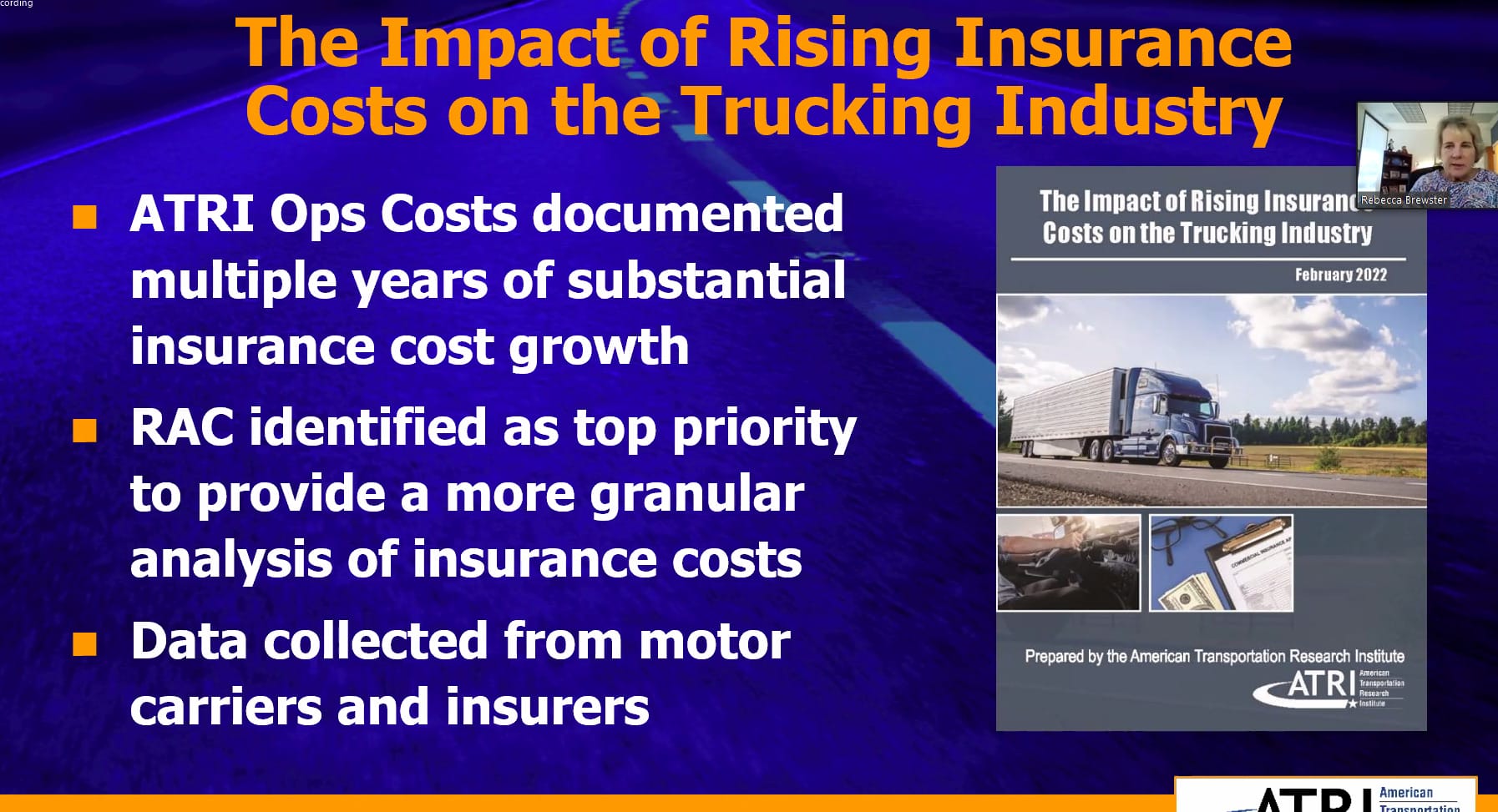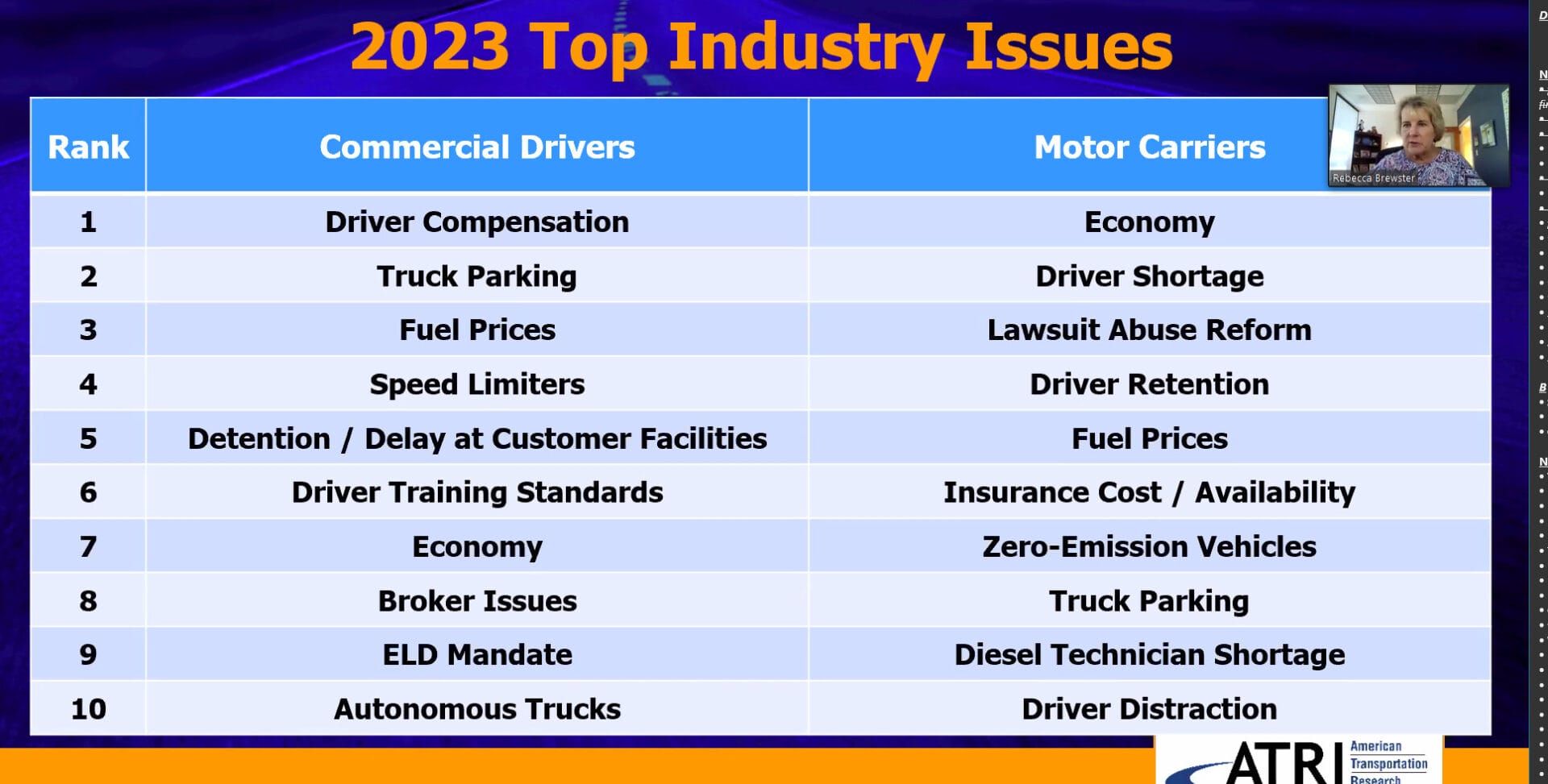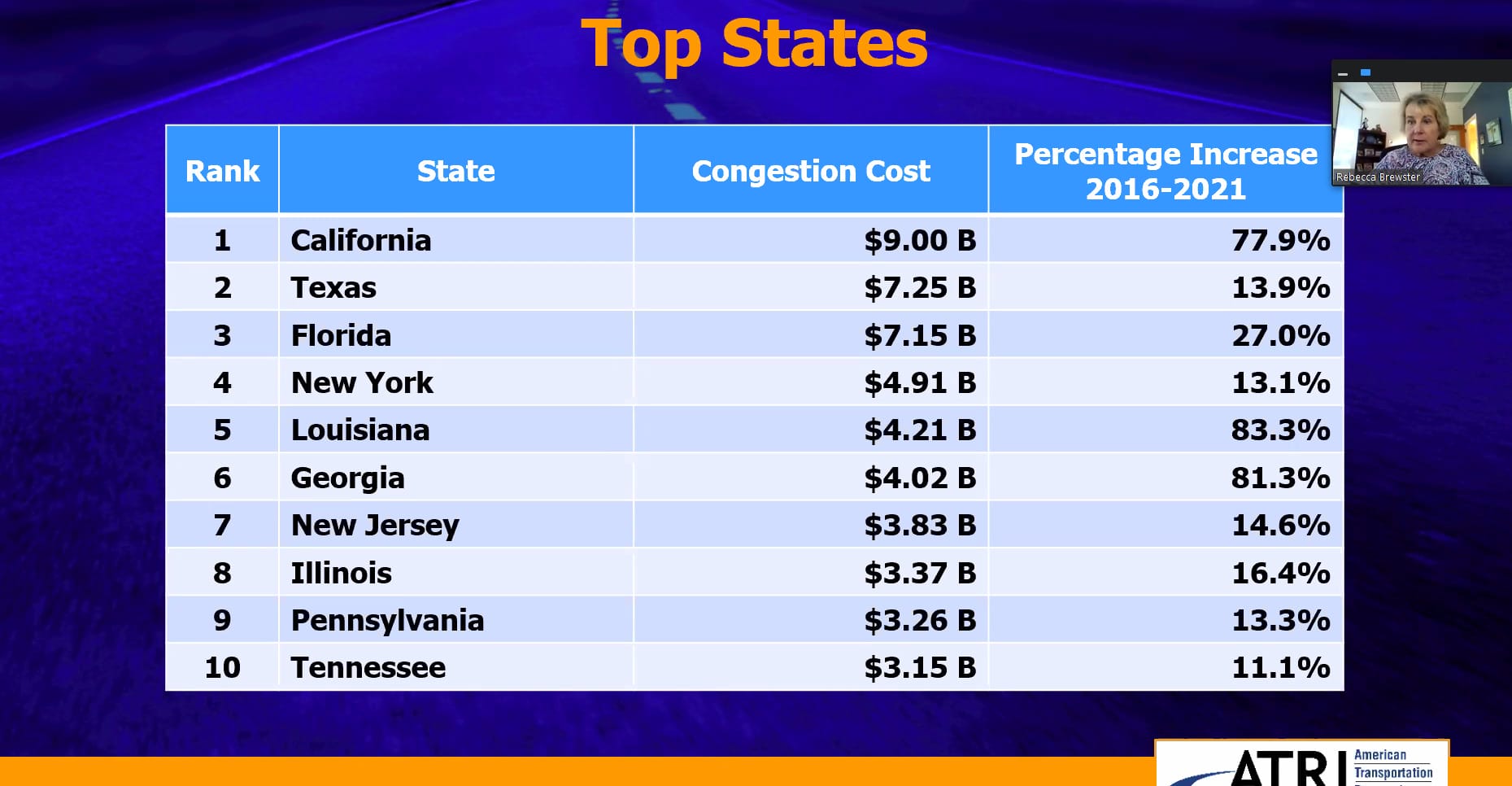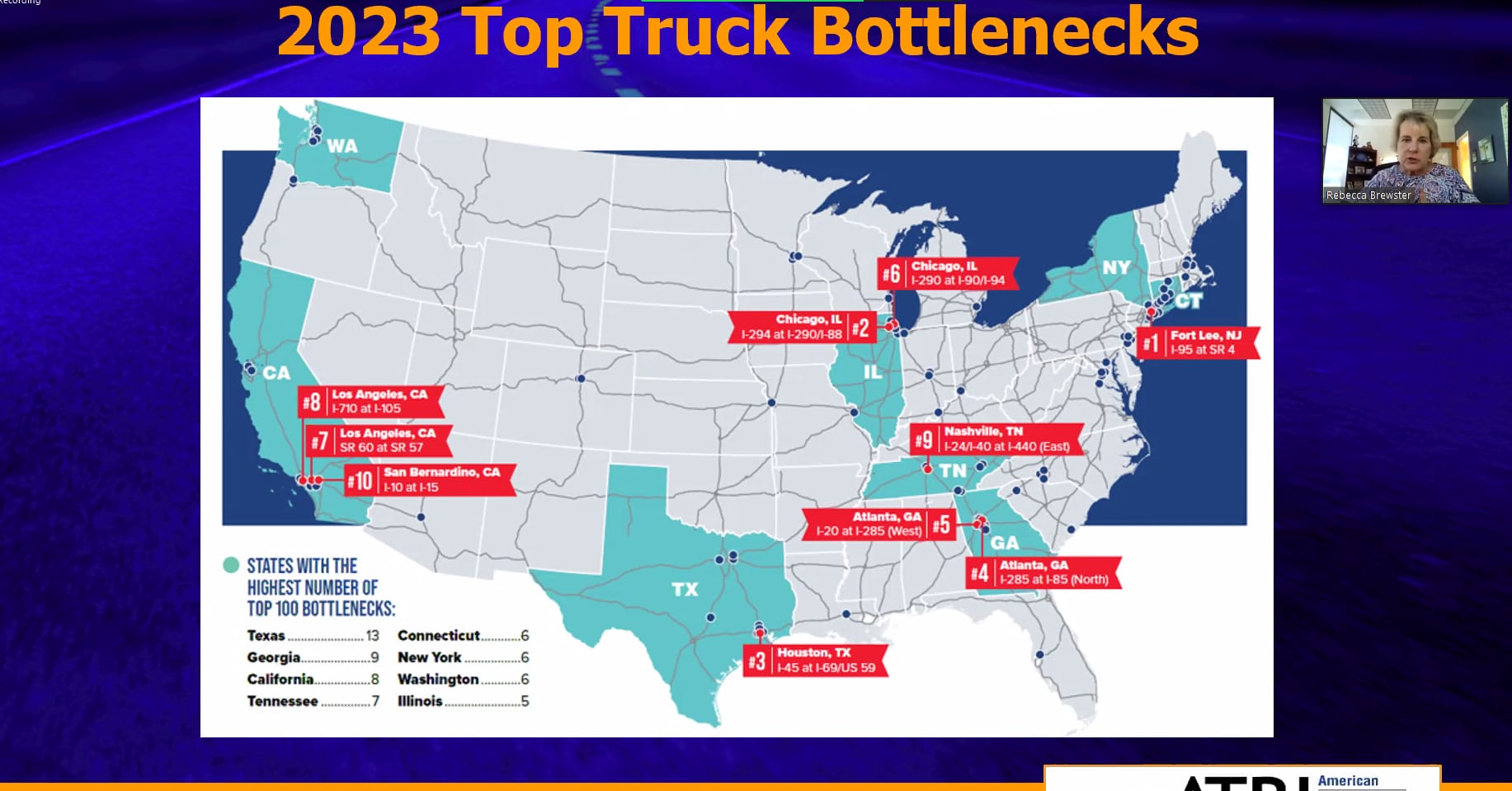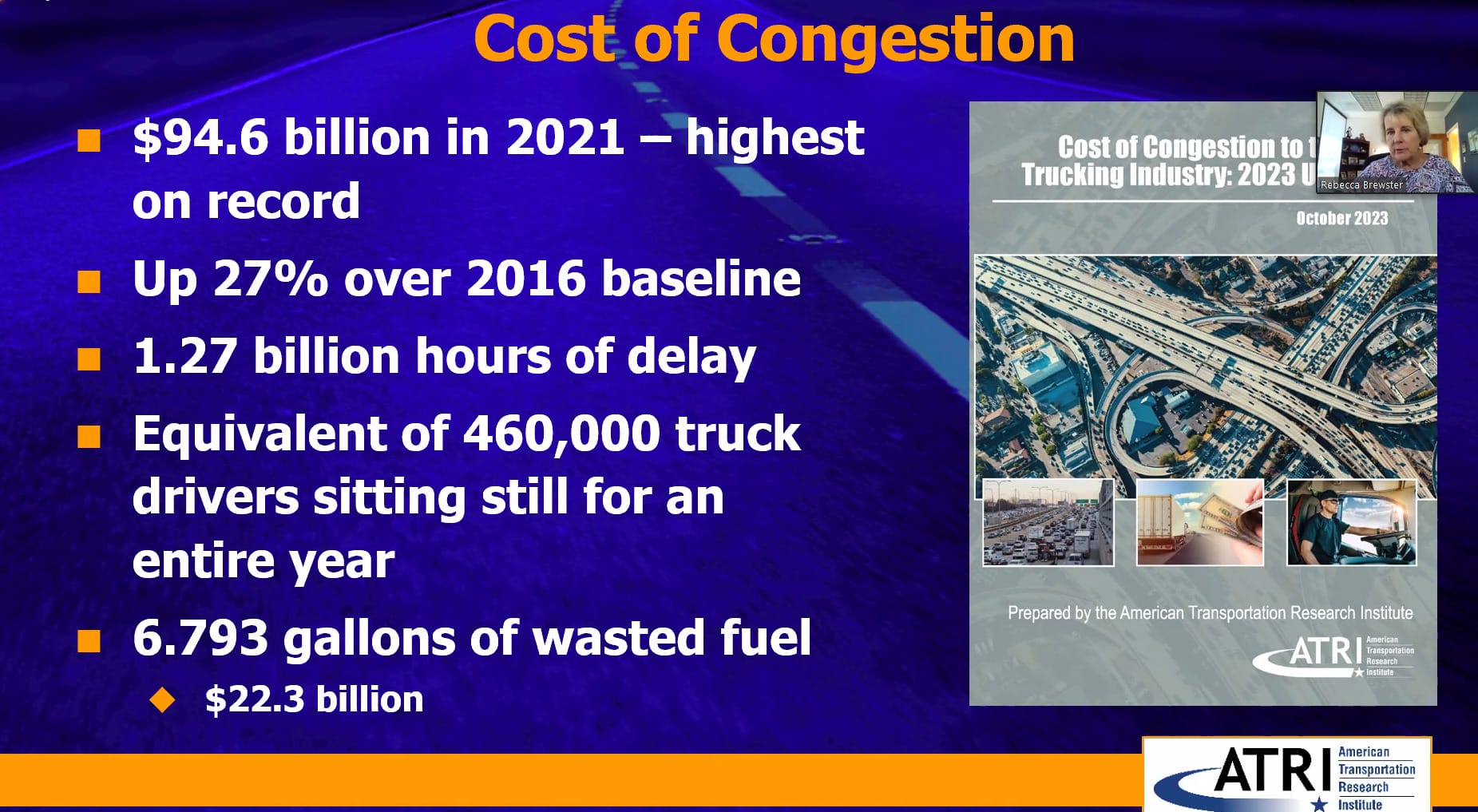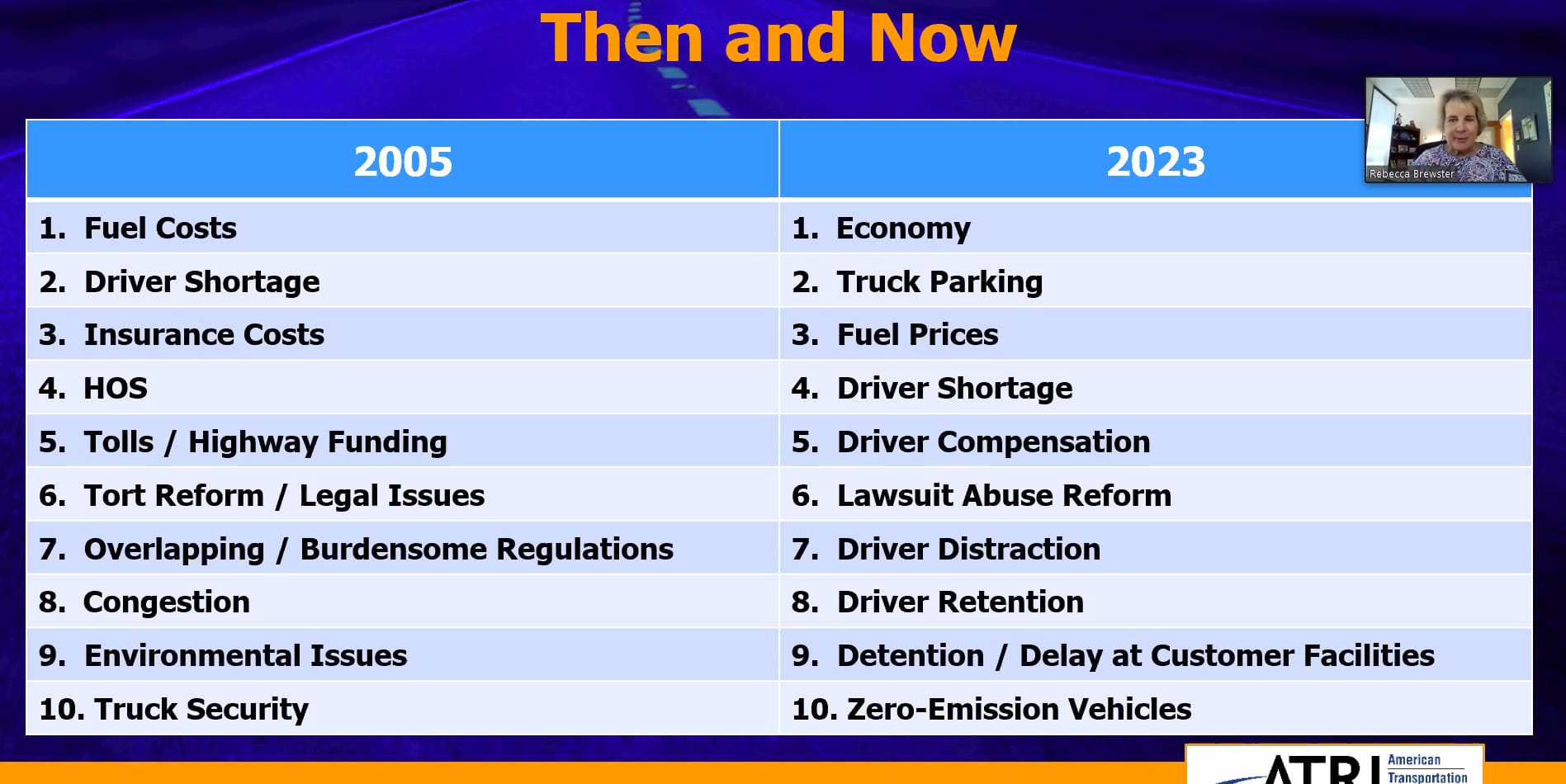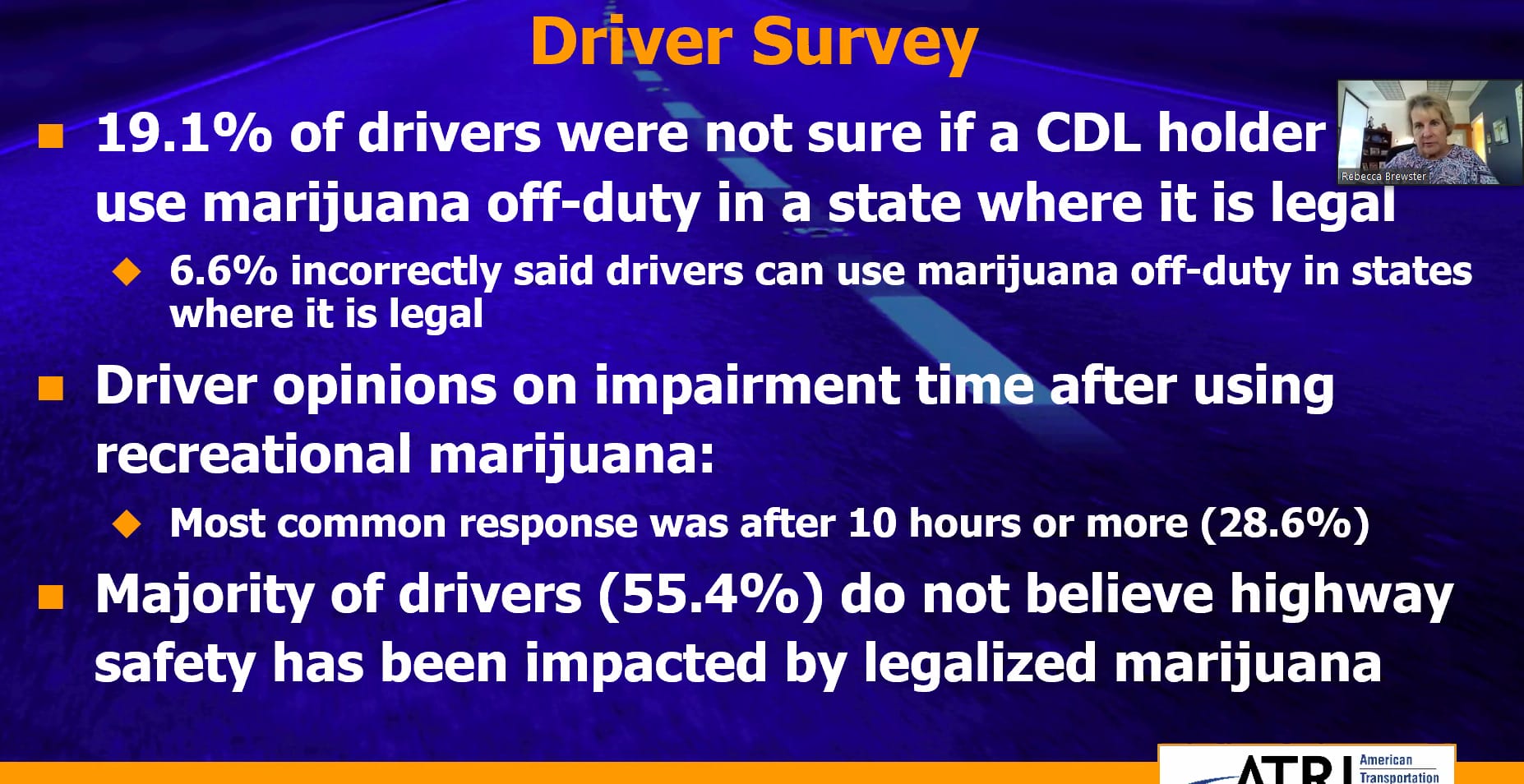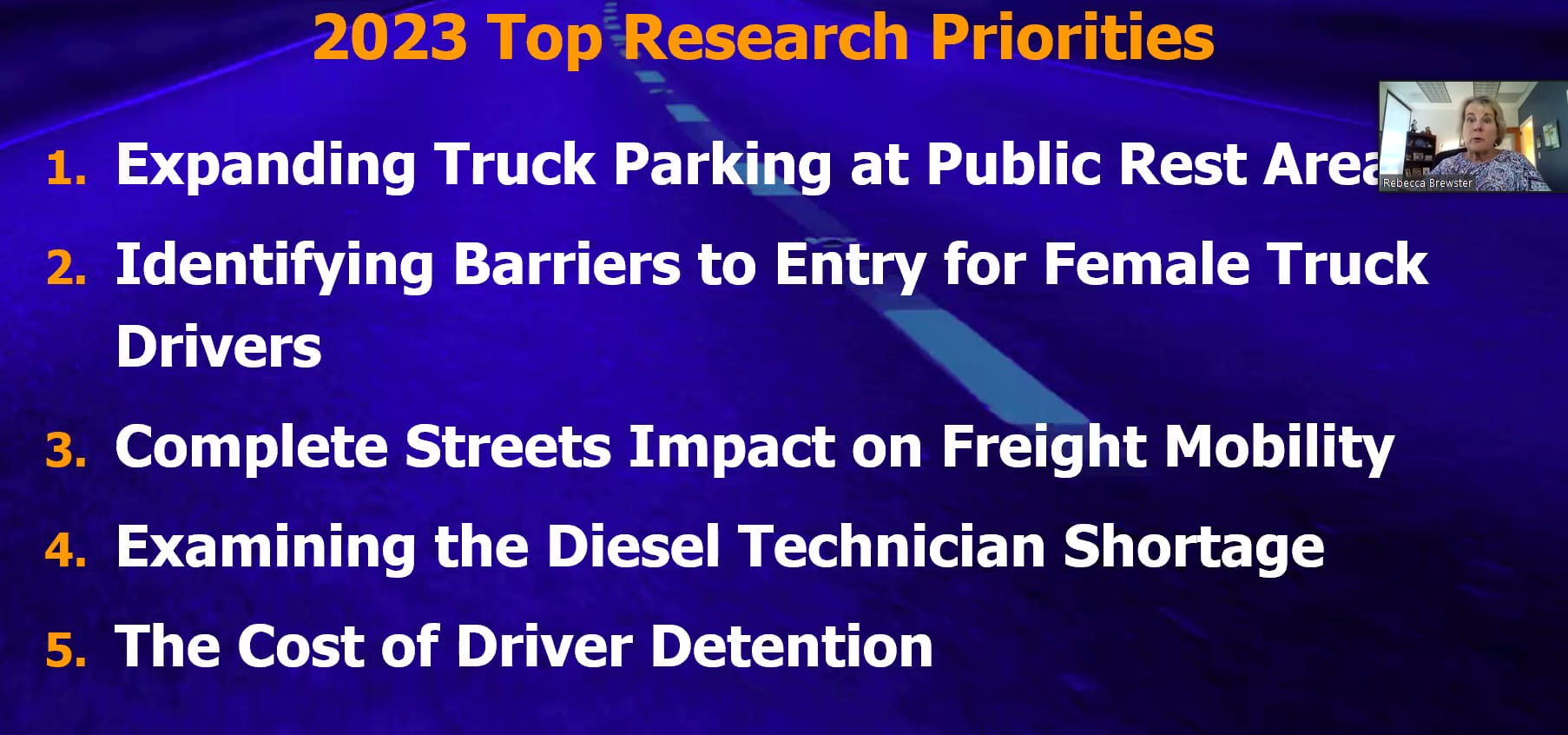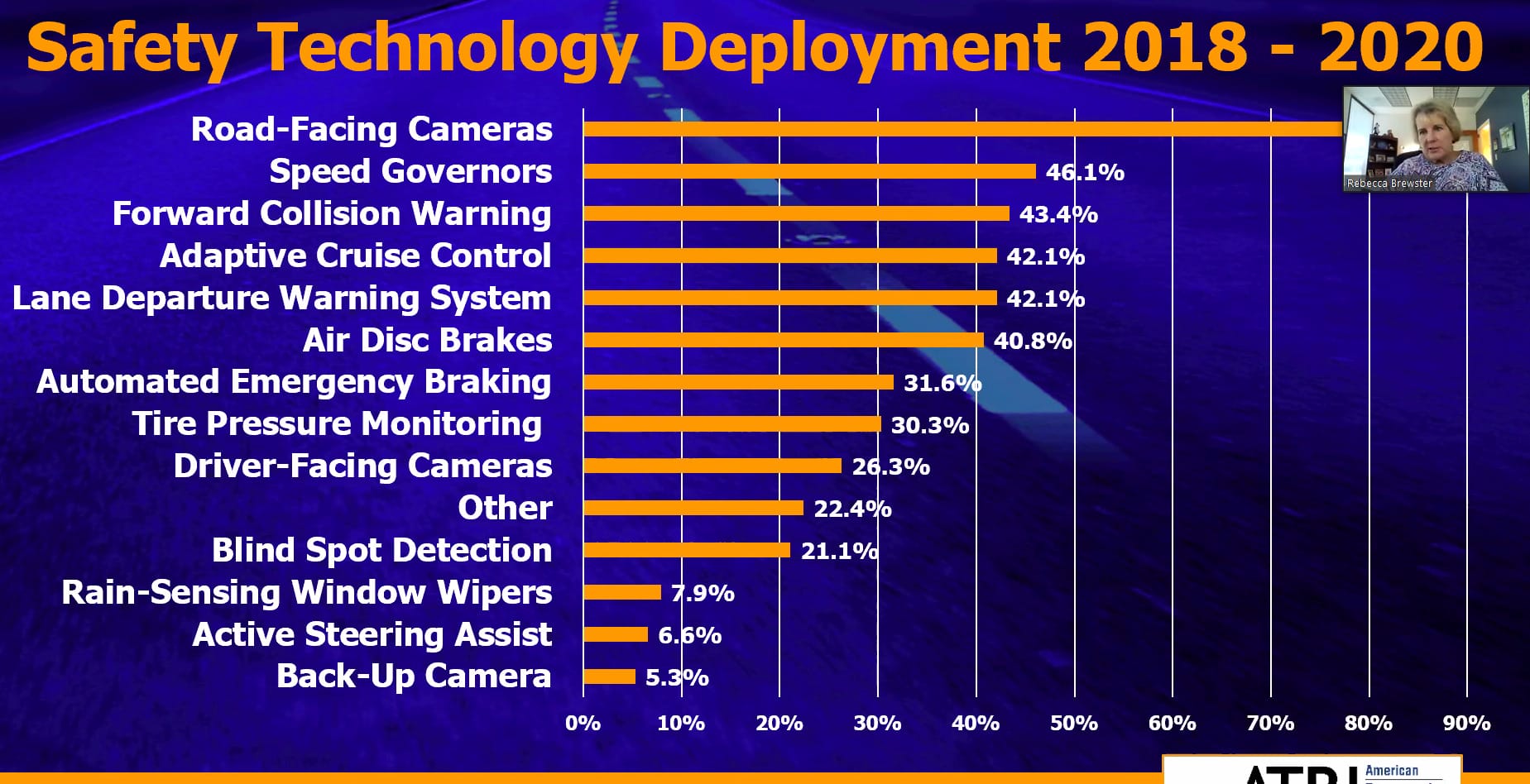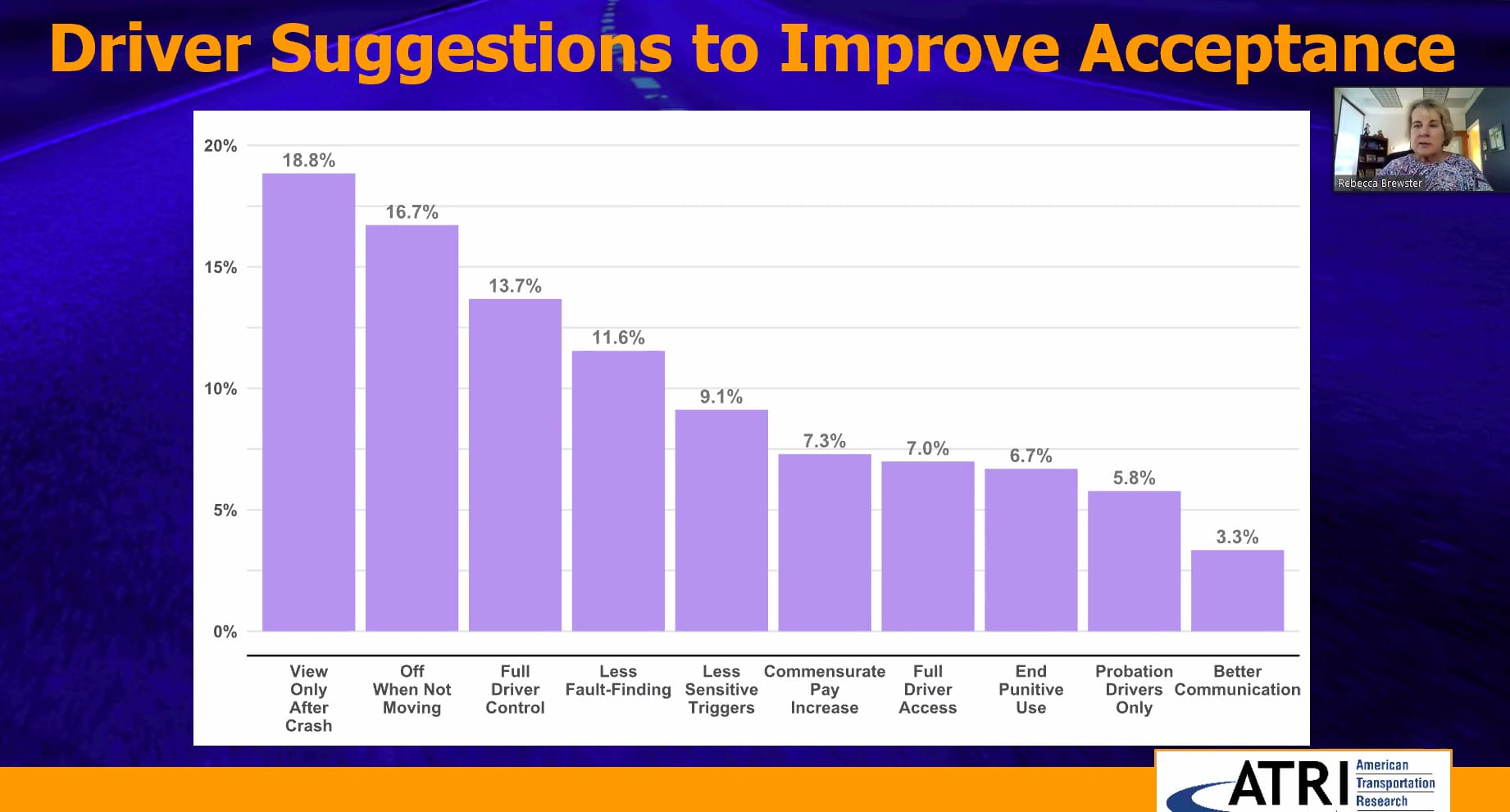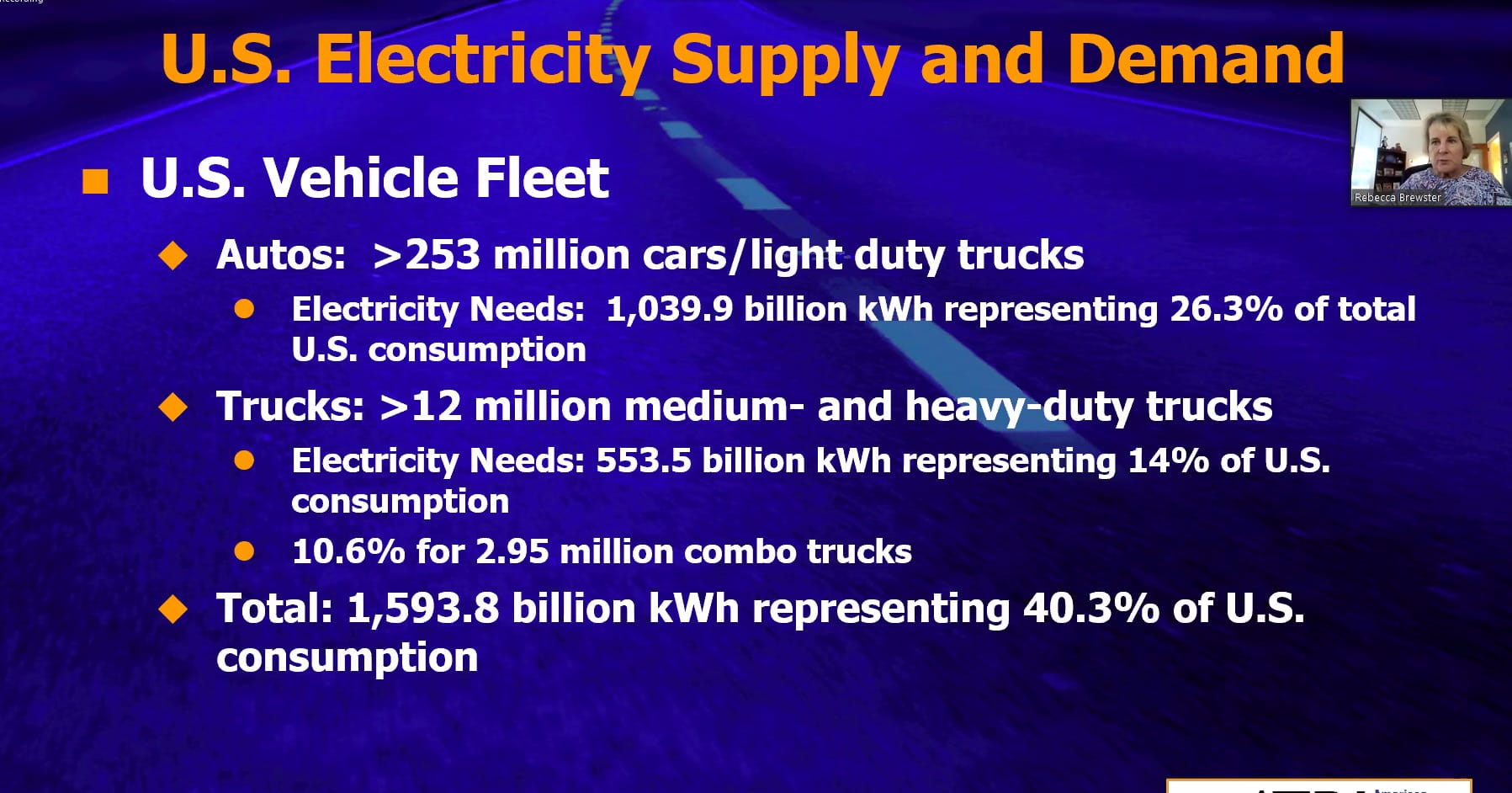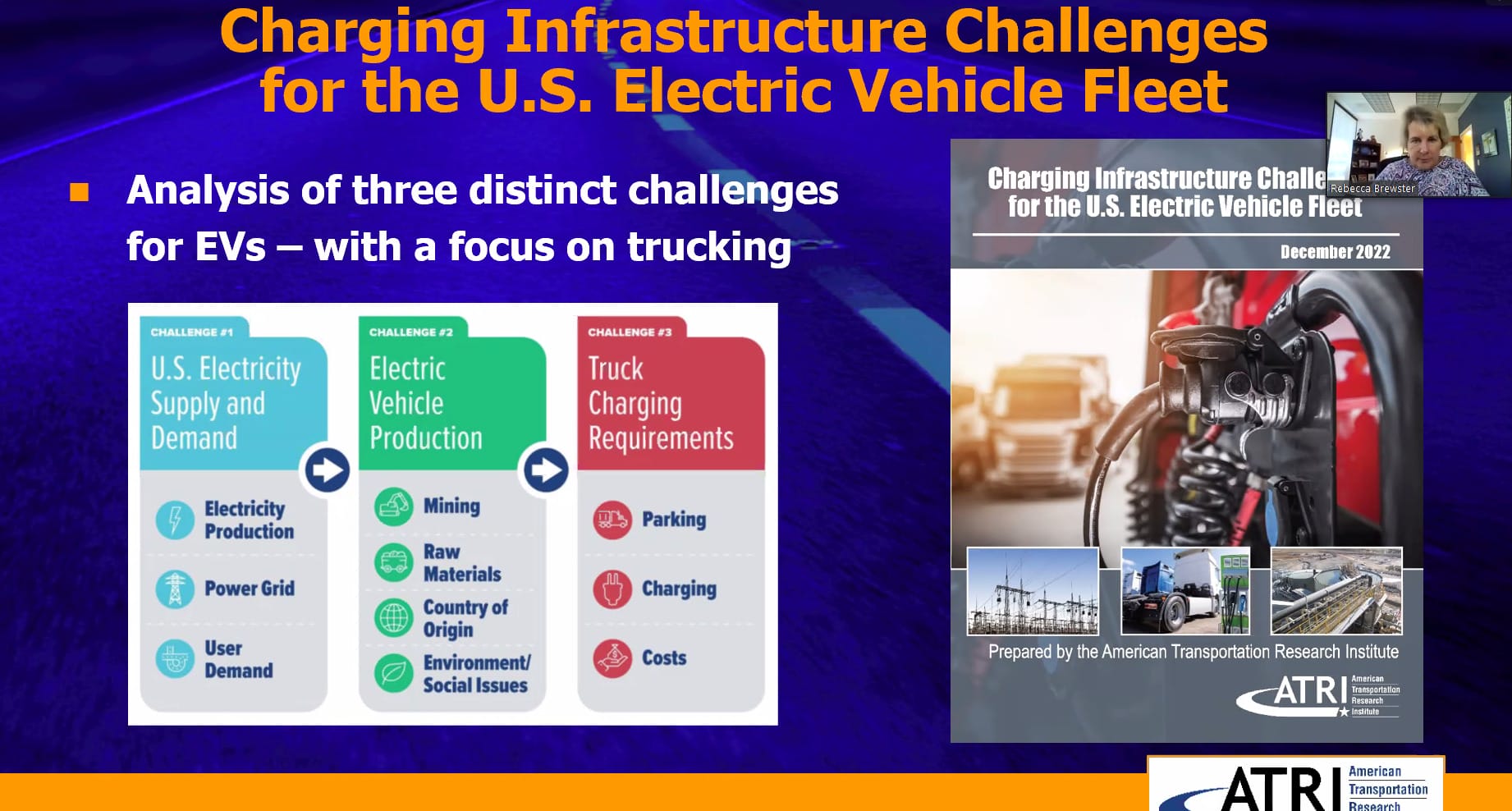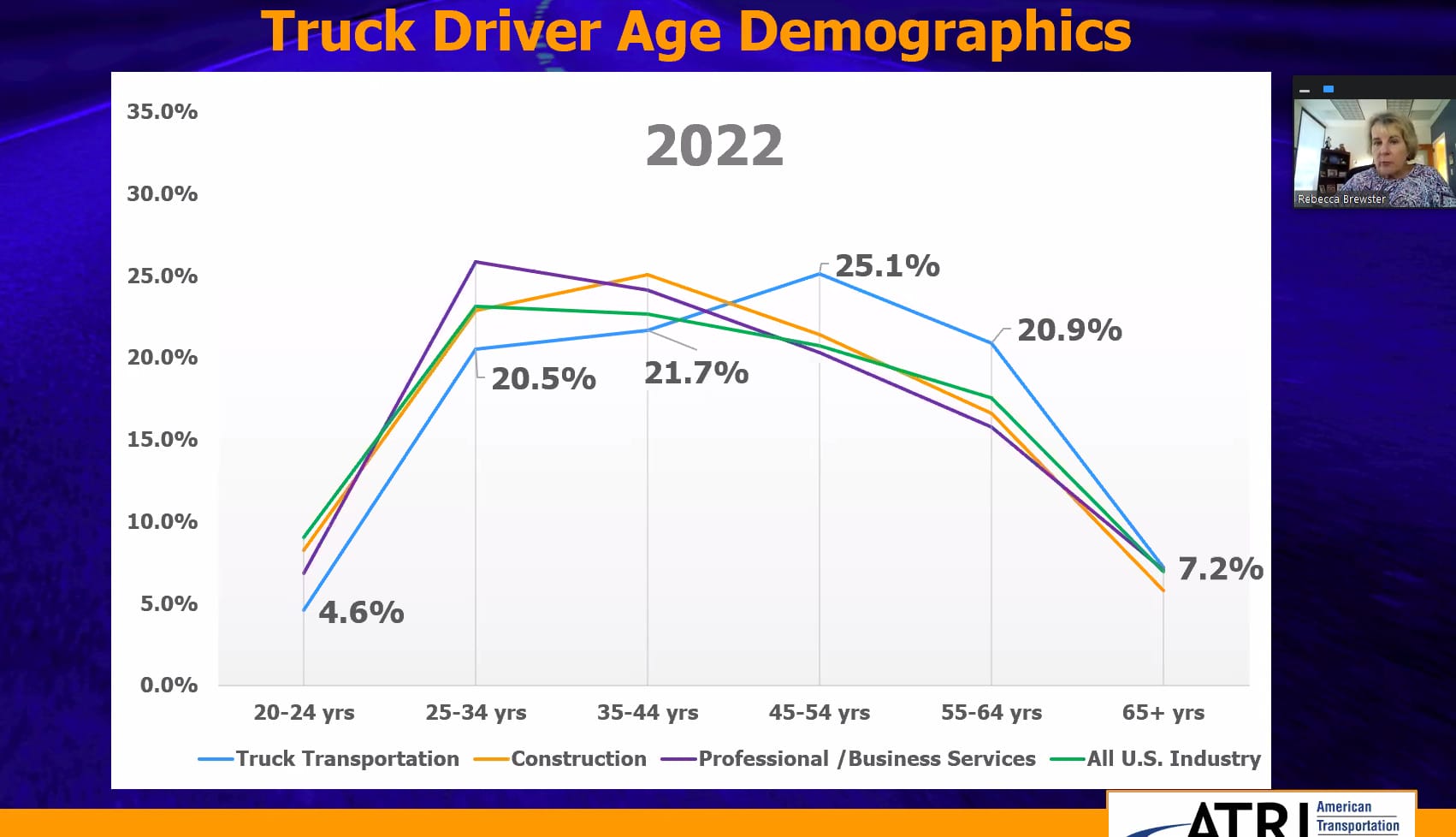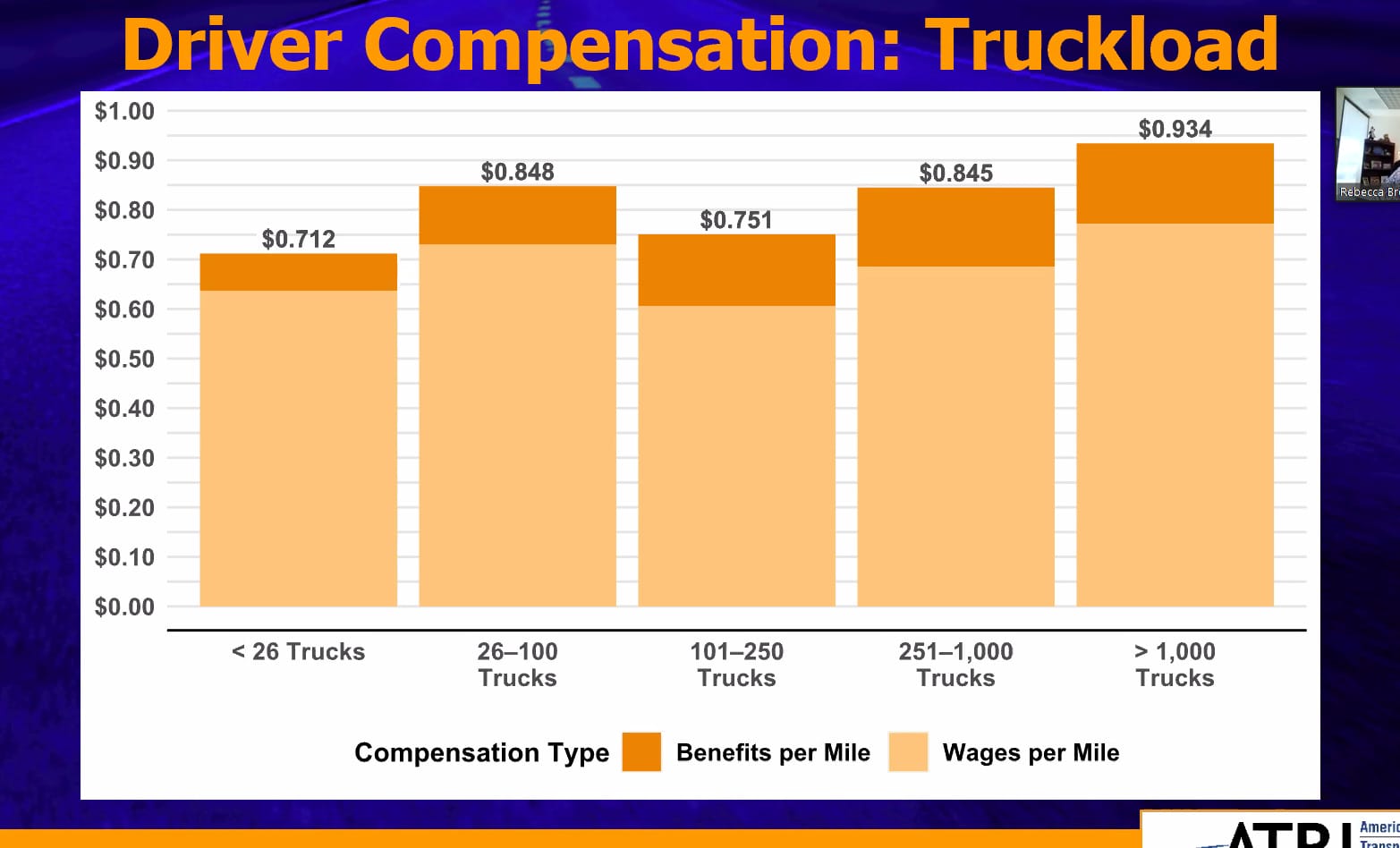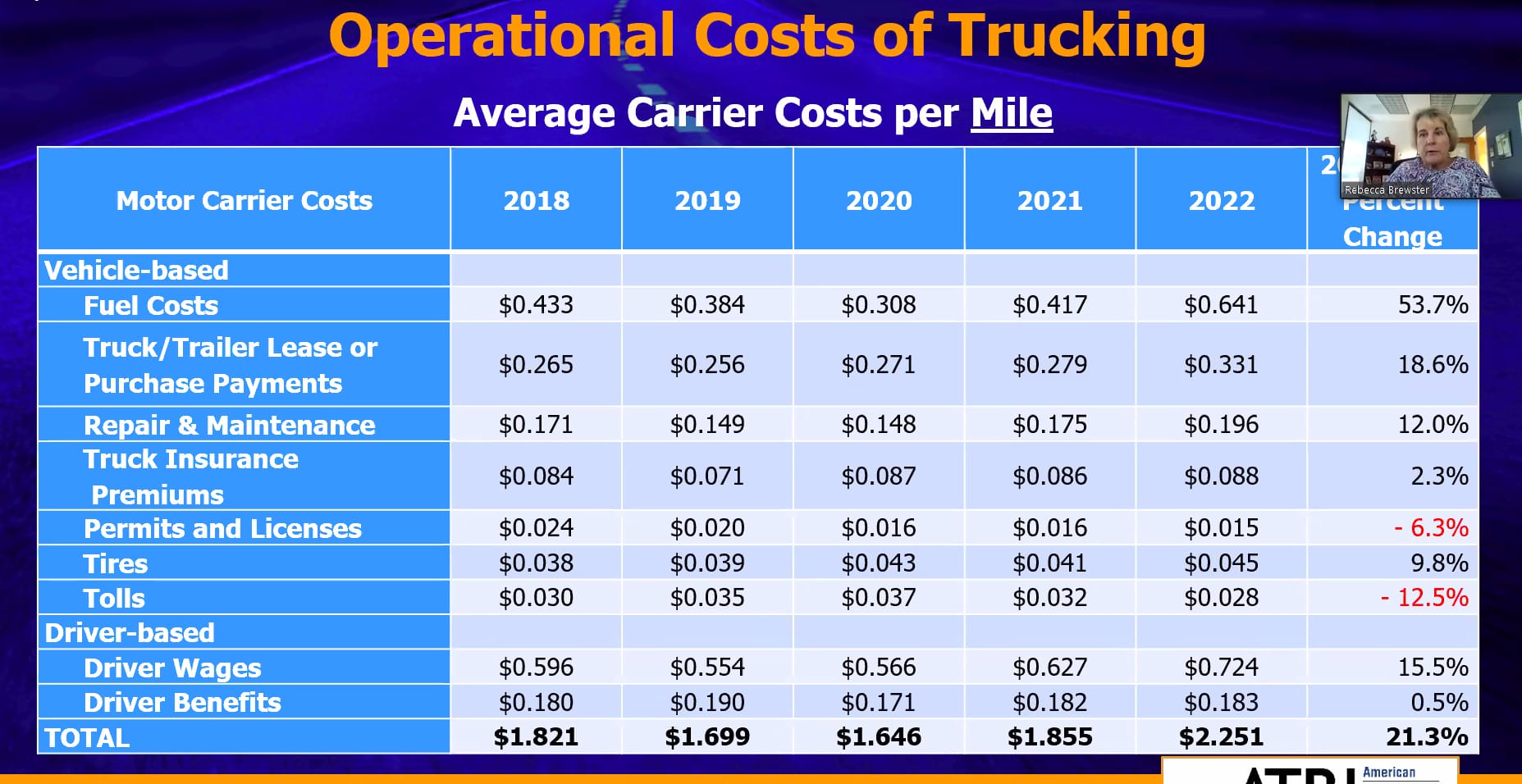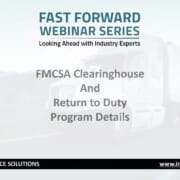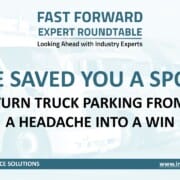Transcription
1
00:00:03.430 –> 00:00:16.879
Steve Kessler: Good afternoon, everybody welcome to the Infinit-I Workforce Solutions. Fast Forward Webinars Series. My name’s Steve Kessler, and I’m gonna be the host of the program this afternoon.
2
00:00:16.960 –> 00:00:42.929
Steve Kessler: Thank you all for coming. I appreciate you taking some of your time to join this afternoon. We’ve got a really great program today. I’m sure many of you have been waiting to hear from Rebecca Brewster at the American Transportation Research Institute, and she’s gonna talk about the I think it’s the nineteenth annual top 10 trucking industry issues.
3
00:00:43.040 –> 00:01:03.089
Steve Kessler: It’s always something that we look very much forward to. So just by a couple of housekeeping things. If you wanna ask a question during the program, go ahead and type it into that chat box there, and we’ll try to take some questions at the end. If we have time we’ll try to keep this to about an hour
4
00:01:03.240 –> 00:01:17.440
Steve Kessler: so why don’t you all do this? Why don’t you jump on the chat tells who you are and who you’re with and where you’re from, so we can kinda get to know who’s out there. And while you all are doing that I’m gonna introduce my co-host.
5
00:01:17.460 –> 00:01:22.720
Steve Kessler: I think, those of you that have been on our webinars in the past. Know who Mark Rhea is
6
00:01:22.900 –> 00:01:43.990
Steve Kessler: Mark is a 35 year plus truck transportation executive. He’s an expert in the industry and certified Director of Safety works in a lot of different areas to consult and help people negotiate through this this trucking business
7
00:01:44.270 –> 00:01:46.439
Steve Kessler: so Mark,
8
00:01:46.460 –> 00:02:08.680
Mark Rhea: How you been. And what do you think about today’s program? Well, we’ve got a really good program. Today, we’ve got Rebecca Brewster from the ATRI, the absolute authority in research in our industry. And I would also just add the UN. Have universal respect in the suppliers, the drivers, the
9
00:02:08.780 –> 00:02:16.540
Mark Rhea: the management of our industry that is so broad, and their work is, is absolutely
10
00:02:16.610 –> 00:02:18.909
Mark Rhea: spot on. So we got
11
00:02:18.980 –> 00:02:26.150
Mark Rhea: the top 10. This got some changes this year. We got some unique things that have hit the top, 10 others easy to identify.
12
00:02:26.450 –> 00:02:31.310
Mark Rhea: They’re not that easy to solve. So I’m really looking forward to Rebecca’s presentation today.
13
00:02:31.900 –> 00:02:52.399
Steve Kessler: Great thanks, Mark. So without any delay, let me go ahead and introduce you all to Rebecca. I’m sure many of you know. Rebecca Brewster. She is the president and chief operating officer of the American Transportation Research Institute. I believe Rebecca has been there about 30 years, so
14
00:02:52.400 –> 00:03:03.560
Steve Kessler: quite a veteran in the business. Rebecca is a recipient of several awards, including Fleet owner magazines, 2016 dozen outstanding women in trucking
15
00:03:03.610 –> 00:03:11.440
Steve Kessler: also the 2,013 influential women in trucking award from the Women and Trucking Association.
16
00:03:11.540 –> 00:03:23.159
Steve Kessler: and the 2,010 Jr. Bob Halliday, award given by the 50 State trucking associations. Rebecca. Thank you so much for joining us, and I’m gonna turn the program over to you.
17
00:03:24.670 –> 00:03:50.880
Rebecca Brewster: Well, Steve and Mark thanks so much for having me on today. It’s it’s this is one of the annual studies we do at Ari, and I’m not gonna lie. It’s one of my favorite ones we do each year. I like it so much that I have in my position, retained the annual analysis of the top industry issues selfishly, because I just love to see each week as I sort of tally the the votes that have come in, how things are going and and how they’re trending. And it really is
18
00:03:50.880 –> 00:03:55.320
just a lot of fun to to really understand what’s happening in the industry. So I
19
00:03:55.320 –> 00:04:20.020
Rebecca Brewster: appreciate the invitation to to talk today about the latest results of Thatry’s top 10. I hope everyone is familiar with our organization. But in the event, you aren’t. We are. The trucking industry’s not for profit research organization. We’re here for one primary mission, and and that is to do the research and provide the data and analysis that makes this trucking industry safer and more productive.
20
00:04:20.089 –> 00:04:43.419
Rebecca Brewster: And one of the key hallmarks of what we do at entry is that we provide all of our research free of charge. And so, as I go through a number of our studies today. If there is something that you are interested in learning more about, I hope you’ll visit our website at trucking research.org. It’s very easy to remember, because it’s what we do. And you’ll find our research there is organized by
21
00:04:43.420 –> 00:04:57.279
Rebecca Brewster: Hot topics. So whether it is economic analysis or hours of service or Csa or truck parking. You’ll find all of our various studies grouped by those research hot topics, and you can download them from our website
22
00:04:57.890 –> 00:05:12.420
Rebecca Brewster: a little bit about how we’re organized at Attree. We are governed by a board of directors made up of the CEO’s of the organizations. You see here. our current chair is Derek Leather, the the chairman of Warner Enterprises, out of Nebraska.
23
00:05:13.070 –> 00:05:35.389
Rebecca Brewster: But where, as I like to say, the real heavy lifting is done at ATRI is by the men and women who are on our research advisory committee. And this is the body that each year reviews typically 20 to 30 different research proposals to collectively identify which ones are going to address the industry’s most pressing needs.
24
00:05:35.420 –> 00:05:42.460
Rebecca Brewster: And what’s so compelling about the work of this group is that they really represent
25
00:05:42.500 –> 00:06:04.360
Rebecca Brewster: the continuum of of experience and trucking. You have large trucking fleets represented. You have small trucking fleets, you have the Allied community and industry suppliers. You have law enforcement academia. There’s a Federal government representative, a State Department of transportation, a metropolitan planning organization truck stop operator.
26
00:06:04.360 –> 00:06:25.449
Rebecca Brewster: and we have professional truck drivers represented. We have both Oida, the owner, operator, Independent Driver Association, as well as one of the America’s road team captains from A. TA. So it really is a a, again, a very diverse group of trucking industry stakeholders who have this one mission. And that’s to figure out what research needs to be done in the trucking industry.
27
00:06:26.590 –> 00:06:41.719
Rebecca Brewster: And one of the primary inputs into that annual process is our annual survey of the top industry concerned. And I hope everyone watching to day has had the chance to take part in this survey, either this year or in previous years.
28
00:06:42.090 –> 00:06:50.960
Rebecca Brewster: This is a survey. We launch every September. It is open to anyone in the industry so much like the membership of our Research Advisory Committee.
29
00:06:51.010 –> 00:06:55.269
Rebecca Brewster: Anyone who has a nexus to trucking is invited to do this survey.
30
00:06:55.420 –> 00:07:07.069
Rebecca Brewster: It’s it’s online. When you take the survey, you are presented with a list of critical issues in the industry this year, where there were 26 of those issues listed on the survey.
31
00:07:07.090 –> 00:07:13.430
Rebecca Brewster: You could. You were asked to pick your top. 3. What are the top 3 that are most impactful for you.
32
00:07:13.520 –> 00:07:41.849
Rebecca Brewster: and then for each of those 3, you are prompted with some potential strategies, and you’re asked to rank those in terms of what you believe their effectiveness would be for addressing each of those issues we allow right ins to the survey. So we’ve had issues over time that have shown up on the survey that were added to the survey, because so many respondents wrote them in. And so it really is a very democratic process for identifying what the industry’s top concerns are
33
00:07:42.160 –> 00:07:52.760
Rebecca Brewster: so this year. Not surprising, I think, to anyone that the state of the nation’s economy was the top issue overall among all industry stakeholders who took the survey.
34
00:07:53.030 –> 00:08:04.109
Rebecca Brewster: The number to the right of each issue is where it ranked in the 2022 survey. So the economy rose 4 spots this year to be the number one issue overall.
35
00:08:04.690 –> 00:08:15.130
Rebecca Brewster: The lack of available truck parking came up one spot, but the number 2 position overall is the highest we have seen truck parking on this annual survey.
36
00:08:15.610 –> 00:08:22.560
Rebecca Brewster: Fuel prices dropped. That was the number one issue last year. Dropped once 2 spots to be number 3 overall
37
00:08:23.100 –> 00:08:41.329
Rebecca Brewster: before fuel prices took over last year as the number one issue. The driver shortage had been the number one issue for 5 years in a row given the softer freight economy at softer freight market. We have seen driver shortage drop down a few spots and rounding out the top. 5. Driver. Compensation.
38
00:08:41.549 –> 00:08:52.820
Rebecca Brewster: 2 new entrants, or relatively new entrants. This year at Number 7. Driver distraction. We have not seen driver distraction in the top 10 since 2,018,
39
00:08:53.220 –> 00:09:17.299
Rebecca Brewster: and then a brand new entry that we had not seen before at all in the top 10 came in at number 10 with 0 mission vehicles, and concern over the very aggressive timelines for the mandates that are out there coming out, of of course, Carb, on the West Coast and California, the States that have adopted the carp timelines and mandates, and then, of course, out of the EPA. So we’ll we’ll talk a little bit about that as well.
40
00:09:18.440 –> 00:09:41.400
Rebecca Brewster: So those are the overall results. And and they’re important. But I think this is where the real value of this annual analysis comes from. And that’s in looking at how motor carriers rank the issues versus how professional truck drivers rank the issues. And if you are a motor carrier and on your list of concerns are finding and keeping drivers.
41
00:09:41.550 –> 00:09:46.909
Rebecca Brewster: Then I really encourage you to understand, certainly appreciate.
42
00:09:47.050 –> 00:09:53.580
Rebecca Brewster: But most importantly, do what you can to impact those issues that drivers say are most important to them.
43
00:09:53.830 –> 00:10:08.359
Rebecca Brewster: On the driver side of the equation, truck, parking and driver compensation go back and forth, depending on the year in terms of their number. One priority ranking among drivers. This year compensation came out on park or on top followed by parking.
44
00:10:08.370 –> 00:10:21.859
Rebecca Brewster: We have a number of owner operators who participate in this survey annually, so you’ll see fuel prices among the driver. Population number 3. Of course it’s not an issue for company drivers, but it certainly is an impactful issue for owner operators.
45
00:10:21.970 –> 00:10:43.129
Rebecca Brewster: Concern over what a potential speed limiter rule making looks like or might look like. It comes in at Number 4 for drivers. And then another of those issues that you do have some control over with your customers is how long your drivers are held up at their facilities. In terms of detention and delay. So again, very interesting to contrast these 2 lists
46
00:10:43.210 –> 00:10:51.320
Rebecca Brewster: I mentioned earlier that we add issues to the survey when they are written in by a number of respondents the previous year.
47
00:10:51.410 –> 00:11:07.690
Rebecca Brewster: number 8 among drivers, broker issues. That was one that in the 2022 survey we had a ton of write ins from drivers expressing concern over various broker issues. And so we added it to the survey, and it made it to the driver. Top 10. This year
48
00:11:10.130 –> 00:11:26.770
Rebecca Brewster: the very first one of the the surveys we did at actually was in 2,005, and I don’t know if this is good news or bad news, but it seems like 19 years later, we are still dealing with many of the same issues.
49
00:11:26.780 –> 00:11:33.210
Rebecca Brewster: You see, fuel prices or fuel costs on both sides of the equation. You see
50
00:11:33.580 –> 00:12:00.360
Rebecca Brewster: tor form lawsuit abuse reform, we call it now environmental issues were concerned in 2,005 when we were concerned about engine standards and fast forward to 2023 when we’ve got 0 mission vehicles in the top 10 list. So it’s just interesting to sort of understand where we were and where we are today, and how in many instances there aren’t a lot of differences between those issues. It’s just how they rank that year.
51
00:12:02.390 –> 00:12:06.780
Rebecca Brewster: Well, that was not what I intended to do. Sorry, gentlemen.
52
00:12:06.790 –> 00:12:08.480
Rebecca Brewster: fast forward.
53
00:12:09.330 –> 00:12:13.640
Rebecca Brewster: That’s what happens when you push the wrong button. Okay, let’s try this again.
54
00:12:14.870 –> 00:12:42.939
Rebecca Brewster: Spoiler. Alert truck parking. I mentioned that it goes back and forth between drivers and between compensation on the driver side of the list. In fact, I think it was 2 years ago. Compensation and truck parking actually tied for the number one issue among drivers, but still a very big challenge for the industry. Going back to my point where I said, as a motor carrier, you need to understand and appreciate the issues that drivers say are important.
55
00:12:42.960 –> 00:12:56.999
Rebecca Brewster: It. It is gratifying to me that we are seeing truck parking on the motor carrier list last year it was Number 10 this year. It’s number 8. So I think it’s it’s rise is just more of that recognition on the part of motor carriers.
56
00:12:57.010 –> 00:13:09.219
Rebecca Brewster: or how impact or impactful this particular issue is. You know, these are pictures that really could be taken, unfortunately, anywhere around the country. And we’ve all seen this where
57
00:13:09.260 –> 00:13:16.709
Rebecca Brewster: at shoulders and ramps, the entrance to, or exits from rest areas. You see trucks parked on the shoulder. And
58
00:13:16.900 –> 00:13:42.560
Rebecca Brewster: it it just is a it’s an untenable situation for that. We put our drivers in that that cannot continue. It has tentacles into everything we do. Quite frankly, it impacts our ability to recruit drivers when this is what it looks like when you tell drivers this is potentially where you have to spend the night parked on a shoulder. Certainly, in terms of keeping drivers in the industry. So it is certainly something we’ve got to do, something about.
59
00:13:42.610 –> 00:13:50.729
Rebecca Brewster: There is now more attention on the part of the Federal Government, and certainly the Us. Do T on this issue. So I am hopeful that.
60
00:13:50.800 –> 00:13:58.580
Rebecca Brewster: But I don’t think we will solve this issue in my lifetime. I do think we are gonna start to see more capacity being added
61
00:13:58.730 –> 00:14:04.650
Rebecca Brewster: for truck parking. Courtesy of the infrastructure. Investment and Jobs Act. So good news on that
62
00:14:05.170 –> 00:14:12.139
Rebecca Brewster: fuel prices number 3 on the driver’s side because of owner operator respondents number 5 over on the motor carrier side.
63
00:14:12.320 –> 00:14:23.510
Rebecca Brewster: This is actually data from the energy information agency that just shows sort of what we’ve seen more recently, and fuel prices, and the in the real climb we saw in 2222
64
00:14:23.560 –> 00:14:44.930
Rebecca Brewster: came down a a little bit at the start of this year, but then it started to climb again in the summer, in the summer. When we look at how company drivers rank the issues versus how owner operators rank the issues fuel prices is number one for owner operators. Not surprisingly in our operational cost of trucking research
65
00:14:44.950 –> 00:15:09.190
Rebecca Brewster: that I’ll talk about in a little bit. Just between 21 and 22. We documented a nearly 54% increase in the fuel costs per mile among participating fleets. So just a real challenging pain point for everybody, and for now there’s not a real good way around it, because that is our primary fuel source. So it it is a real challenge for us in the industry.
66
00:15:10.520 –> 00:15:19.360
Rebecca Brewster: and certainly it is not aided by the fact that we spend a lot of time in congestion and waste a lot of fuel.
67
00:15:19.660 –> 00:15:28.210
Rebecca Brewster: So this is the newest actually release. We just put this one out. It is an update to earlier research. We call our cost of congestion
68
00:15:28.390 –> 00:15:39.939
Rebecca Brewster: where we use our very extensive truck GPS data set over hundreds of thousands of trucks worth of GPS data comes into us in real time, we monitor traffic congestion.
69
00:15:40.050 –> 00:15:49.029
Rebecca Brewster: And here we look at how much lost productivity there is across the entire national highway system.
70
00:15:49.470 –> 00:15:51.700
Rebecca Brewster: And so in 2021
71
00:15:51.760 –> 00:15:58.670
Rebecca Brewster: that was 1.2 billion hours of delay for trucks sitting in stuck in traffic congestion.
72
00:15:58.690 –> 00:16:01.929
Rebecca Brewster: You use that operational cost of trucking data
73
00:16:01.970 –> 00:16:10.730
Rebecca Brewster: that totals up to almost 95 billion dollars. Congestion cost the industry in 2021. That’s the highest we have ever seen.
74
00:16:11.150 –> 00:16:19.049
Rebecca Brewster: Those hours of delay. And and this one just bears repeating 1.2 7 billion hours of delay
75
00:16:19.250 –> 00:16:25.540
Rebecca Brewster: is the equivalent of 460,000 truck drivers sitting still for an entire year.
76
00:16:26.000 –> 00:16:35.289
Rebecca Brewster: When you think about the numbers that come out of the American Trucking associations for the driver shortage. Again, a high issue on the motor carrier side of the equation.
77
00:16:35.500 –> 00:16:50.610
Rebecca Brewster: That shortage number runs, depending on the year somewhere between 65 and 85,000 drivers needed in the over the road sector. and we have what equates to 460,000 drivers going nowhere for an entire year because of congestion
78
00:16:51.110 –> 00:16:55.230
Rebecca Brewster: getting back to fuel prices. Those hours of delay
79
00:16:55.250 –> 00:17:05.700
Rebecca Brewster: equate to wasted fuel in 2021. That was 6.7 9 3 1 billion, and that should be not just gallons. We didn’t voice
80
00:17:05.710 –> 00:17:22.319
Rebecca Brewster: 6.7 gallons. That would not be much that should be billing to waste and fuel at a cost of 22 billion dollars. So just a big big expense for the trucking industry. 6.8 billion gallons. Correct? Yes, it is 1 billion gallons. Would it be?
81
00:17:22.780 –> 00:17:23.510
Mark Rhea: Okay?
82
00:17:25.829 –> 00:17:48.509
Rebecca Brewster: Of course, congestion is not equal opportunity. Depending on what state you’re in? You are going to experience those congestion costs. So this is a factor of not only how bad the congestion is, but how many vehicle miles travel there are by trucks in that State. And so congratulations, Mark, you guys are number 2 over all in Texas.
83
00:17:48.510 –> 00:18:06.670
Rebecca Brewster: Only by California. But but some surprises on this list, I think when people think about big population states, big size, geographic size States. States. Congestion choke points. Louisiana. Number 5 probably doesn’t jump to mind right away.
84
00:18:06.780 –> 00:18:13.700
Rebecca Brewster: But the fact of the matter is, that is a great poster, child, for why we need infrastructure investment.
85
00:18:13.720 –> 00:18:18.829
Rebecca Brewster: So they’ve had tremendous growth in port traffic of both
86
00:18:18.880 –> 00:18:21.920
Rebecca Brewster: sort of New Orleans as well as Shreveport
87
00:18:21.970 –> 00:18:27.519
Rebecca Brewster: and so we’ve got lots of truck traffic, but we also have
88
00:18:27.840 –> 00:18:48.479
Rebecca Brewster: infrastructure badly, badly in need of repair when you look at the score cards. For how infrastructure is rated Louisiana routinely does, poorly, because they just have not kept up their infrastructure. And so because of that more congestion trucks having to go more slowly, and it adds up to congestion costs. So another reason why
89
00:18:48.490 –> 00:18:53.929
Rebecca Brewster: we need to make sure that the infrastructure investment at And Jobs Act monies are spent.
90
00:18:53.960 –> 00:18:58.470
Rebecca Brewster: To to address these real, significant congestion issues
91
00:19:01.320 –> 00:19:28.800
Rebecca Brewster: the other and probably more famous analysis we do every year where their truck GPS data is the list of the top 100 truck bottlenecks. So this one’s a little different. For this analysis. We are monitoring traffic congestion at 300 specific, 300 plus specific locations around the country. We take a full calendar year’s worth of GPS data. We look at how slowly trucks are operating, and how many trucks are impacted in each one of those occasions.
92
00:19:28.830 –> 00:19:52.869
Rebecca Brewster: Speed and volume go into a calculation to come up with the 100 worst places to operate a truck. So you see the top 10, they’re indicated by those red flags. The States that are highlighted in blue have the most of those top 100 locations, and once again Texas is a leader. Texas has 13 of the nation’s top truck bottlenecks.
93
00:19:53.380 –> 00:19:58.470
Rebecca Brewster: and in fact, 9 of those 13 are in and around the Houston area.
94
00:19:58.510 –> 00:20:19.829
Rebecca Brewster: But but big doesn’t necessarily mean traffic congestion, because when you look to our friends up in the northeast, you see Connecticut, which no one ever thinks of as a big state, because it’s not, and it has 6 of the nation’s top truck bottlenecks all located along Interstate 95 that I 95. Corridor up through the northeast is just really challenging.
95
00:20:20.490 –> 00:20:28.709
Rebecca Brewster: Here are those top 10 locations, and what you can see here is the average rush hour speed for each of those.
96
00:20:28.860 –> 00:20:45.289
Rebecca Brewster: So the number one location has been the number one location for several years. I don’t see it dropping out of the top spot for anytime soon. that is, the New Jersey side of the George Washington Bridge, which connects New York and New Jersey.
97
00:20:45.370 –> 00:20:50.459
Rebecca Brewster: It is a location where 6 roads come together to a toll bridge.
98
00:20:50.600 –> 00:21:11.109
Rebecca Brewster: and so there’s so much development around those 6 roads coming to that toll bridge, and and it is, does come to a bridge that there isn’t really a whole lot that can be done to fix that. And so unfortunately, that’s not one that’s going to disappear off the list. But there are others where I am hopeful that we will see those locations go down
99
00:21:11.140 –> 00:21:22.470
Rebecca Brewster: the one we always point to is Number 6 for folks who are familiar with that location in Chicago. It is now called the Burn Interchange. It used to be called the Circle Interchange.
100
00:21:22.580 –> 00:21:38.459
Rebecca Brewster: and it was the number one location on our list for 3 years in a row when we first started doing this annual analysis the State of Illinois at that point issued a press release and said, we no longer want to have the top truck bottleneck. So we’re gonna do something about it.
101
00:21:38.580 –> 00:21:49.049
Rebecca Brewster: That project has been under way for many years now. It is almost done. And so, as we have seen with some other locations that were under construction.
102
00:21:49.080 –> 00:22:06.229
Rebecca Brewster: Once the project is done, we do see those locations drop down in the list, so where we have an opportunity to wisely invest those infrastructure dollars. I think we can start to see some of these locations either drop down in ranking or see those average truck speeds get better.
103
00:22:08.790 –> 00:22:32.309
Rebecca Brewster: Driver, shortage driver, retention. Again. Both drop down a little bit on the motor carrier side and on the overall list, but still still big issues. And certainly is, if we not if. But when we see the economy start to recover and freight demand, go back up we’re we’re always gonna need drivers. And so finding and keeping drivers are critical
104
00:22:32.380 –> 00:22:34.099
Rebecca Brewster: features for fleets.
105
00:22:34.290 –> 00:22:51.449
Rebecca Brewster: One of the challenges, of course, as an industry is the age of our driver workforce. And so this compares the trucking industry’s workforce, the drivers in blue, there to professional and business services construction, and, in fact, the entire Us workforce the green line.
106
00:22:51.660 –> 00:23:05.229
Rebecca Brewster: And on the good news side, you can see that of those 4 groups, we have the highest percentage in the 45 and over age brackets. And so I like to think that’s good news for us, because it means we have older.
107
00:23:05.500 –> 00:23:23.710
Rebecca Brewster: more mature, and typically more experienced drivers, but where it is a real problem for us and and really spells trouble down. The road is on the left side of that figure. Where of those 4 groups, we have the lowest percentage in that 20 to 24 year age bracket with just 4.6%. Of our driver workforce.
108
00:23:23.880 –> 00:23:31.290
Rebecca Brewster: And this is data that comes from the the Bureau of Labor Statistics. So as the men and women on the right side begin to retire.
109
00:23:31.300 –> 00:23:44.779
Rebecca Brewster: we are unfortunately not doing a good job on the left side of bringing young people into the industry to fill those spots. And so I I’m afraid that spells trouble for us down the road in terms of our our driver workforce
110
00:23:45.580 –> 00:23:59.420
Rebecca Brewster: our Research Advisory committee, recognized this challenge, and in 2021 identify this study as a priority for us. I don’t have a lot of slides on it, but I but I do want to point out if you are a fleet who is interested
111
00:23:59.510 –> 00:24:01.060
Rebecca Brewster: in sort of
112
00:24:01.140 –> 00:24:25.240
Rebecca Brewster: bringing on younger folks, you know, examining your own practices for how you onboard younger individuals within your fleet. I would highly recommend you download this study. It really has fabulous information. Gleaned from fleets that were successfully integrating younger folks and particularly younger drivers into their fleet, and for this study we called younger anybody under 25.
113
00:24:25.460 –> 00:24:29.370
Rebecca Brewster: But I think, most importantly, we talk to younger drivers.
114
00:24:29.510 –> 00:24:56.860
Rebecca Brewster: What first attracted you to a driving career. What did you think of the training you received? And what’s gonna keep you around for the for the long haul? And so lots of great information in it, and I would highly encourage you to to ex download this one. If you are interested in bringing younger individuals on into your fleet, and I think we all have a vested interest in making sure we do so, to make sure we don’t have a tougher driver. Shortage situation in the future.
115
00:24:58.440 –> 00:25:03.870
Rebecca Brewster: Obviously a big work force impact for us right now is the growing legalization of marijuana.
116
00:25:04.860 –> 00:25:21.440
Rebecca Brewster: Everyone has seen the numbers out of Fmcs A’s drug and alcohol clearing house, and the 100 of 100,000 plus drivers who have tested positive either on a pre employment or even worse. In a random or a post crash test
117
00:25:21.520 –> 00:25:29.150
Rebecca Brewster: and not initiated the return to duty process. And so those drivers are leaving the industry.
118
00:25:30.240 –> 00:25:36.460
Rebecca Brewster: Another major reason were were challenged in terms of our workforce.
119
00:25:36.770 –> 00:25:56.719
Rebecca Brewster: So to do this research, we did a motor carrier survey that I’ll share a couple of the findings from. But I wanted to point out the driver survey. We have never at actually had such big response to a driver survey as we did on this particular topic. Over 3,300 drivers responded to this survey alone.
120
00:25:56.780 –> 00:26:00.239
Rebecca Brewster: and to me it really pointed out how
121
00:26:00.540 –> 00:26:25.499
Rebecca Brewster: very strongly drivers feel about this topic. At one end of the continuum. You have drivers who feel very strongly that things should re remain the way they are that Cdl drivers should not be allowed to use marijuana, and at the other end of the continuum you have drivers who feel very strongly that they are legally allowed to have a beer or 2 over the weekend and start driving on Monday.
122
00:26:25.690 –> 00:26:34.870
Rebecca Brewster: and they feel that the same should be true for marijuana if it is legal in their state, so a a real difference of opinion among the driver population there.
123
00:26:35.820 –> 00:26:56.939
Rebecca Brewster: So this is what the current landscape looks like when you look at recreational marijuana. So we actually did a study in 2019, looking at this growing legalization and that study really focused on what would be this roadway safety impacts as our drivers. We’re now gonna share the road with more likely impaired car drivers.
124
00:26:56.940 –> 00:27:06.009
Rebecca Brewster: So the States, in dark green, particularly the folks on the West Coast plus Colorado, where, among the earliest ones to legalize recreational marijuana
125
00:27:06.060 –> 00:27:24.340
Rebecca Brewster: fast forward to 2023 the States in the shady green are ones who have since then legalized recreational marijuana. So a lot of certainly availability of legally recurable recreational marijuana, and, in fact.
126
00:27:24.410 –> 00:27:27.889
Rebecca Brewster: again, using 2019 as sort of the benchmark for us
127
00:27:28.660 –> 00:27:45.829
Rebecca Brewster: nearly 50% of the US. Population now lives in states where recreational marijuana is legal, and among CDL. Holders. that’s just over 41% live in States where they can legally use marijuana except for that
128
00:27:46.280 –> 00:27:49.019
Rebecca Brewster: little caveat that their CDL. Holders.
129
00:27:51.070 –> 00:27:58.020
Rebecca Brewster: So II think this is indicative of of how significant the driver shortage is impacting fleets.
130
00:27:58.100 –> 00:28:06.060
Rebecca Brewster: We ask on the motor care survey. Would you consider hiring someone who had at 1 point in the past tested positive for marijuana.
131
00:28:06.100 –> 00:28:21.569
Rebecca Brewster: and I was very surprised to see that 56%. Of the respondents said we might hire that driver. Now we ask how much time would have had to have elapsed between that positive test and when they would, considering, hire them. And that was typically in the 5 to 10 year range.
132
00:28:21.680 –> 00:28:27.969
Rebecca Brewster: But just the fact that Fleet say we might consider this tells me they’re just
133
00:28:28.140 –> 00:28:35.529
Rebecca Brewster: addressing the reality, that it’s legal in so many places, and we have such a need to fill seats.
134
00:28:35.930 –> 00:28:47.419
Rebecca Brewster: How concerned are you as a fleet that you are? Your drivers gonna drive impaired because of of impaired from marijuana because of legalization, and certainly some concern about that.
135
00:28:48.040 –> 00:28:58.739
Rebecca Brewster: But where the real concern comes up because of what this would mean in terms of litigation is how concerning you that a driver is likely to test positive for marijuana
136
00:28:59.070 –> 00:29:01.340
Rebecca Brewster: in a post crash drug screen.
137
00:29:01.540 –> 00:29:16.760
Rebecca Brewster: And again, the challenge with marijuana is the latency in your system. How long it stays with you, so you may no longer be impaired from marijuana if you used it. You know a week ago, but if it shows up in your system
138
00:29:17.320 –> 00:29:29.729
Rebecca Brewster: in a post crash screening now, it opens up a whole new realm of possibilities for litigation and and a whole host of other problems. So a lot of concern among fleets about that.
139
00:29:29.820 –> 00:29:34.499
Rebecca Brewster: No, no, Rebecca, were those 2022 numbers.
140
00:29:35.150 –> 00:29:47.429
Rebecca Brewster: This is where I think we have a real opportunity as an industry. So 25% of the drivers in again, the largest response to a survey we’ve ever had by drivers.
141
00:29:47.460 –> 00:29:49.639
Rebecca Brewster: 25% of drivers
142
00:29:49.650 –> 00:29:53.710
Rebecca Brewster: either weren’t sure or incorrectly believed
143
00:29:53.740 –> 00:29:57.950
Rebecca Brewster: that they could use marijuana if they lived in a state where it was legal.
144
00:29:59.070 –> 00:30:04.509
Rebecca Brewster: We have got to do a better job of educating our drivers and making sure they understand
145
00:30:04.670 –> 00:30:16.610
Rebecca Brewster: that marijuana use. And a Cdl is a no go period. That’s it. It just is in until you know Federal law changes. That is absolutely a no go.
146
00:30:16.810 –> 00:30:21.179
Rebecca Brewster: The other one that surprised me was that last bullet point there that
147
00:30:21.390 –> 00:30:28.829
Rebecca Brewster: drivers do not believe that roadway safety has been impacted by marijuana legalization.
148
00:30:29.110 –> 00:30:32.660
Rebecca Brewster: I live in Atlanta, and I can tell you
149
00:30:32.700 –> 00:30:47.039
Rebecca Brewster: if you roll your windows around driving around here, even though we’re not one of those states where it’s legal. it’s everywhere. You can smell it everywhere. And so II personally believe it’s impacting roadway safety because I can smell so many people using it while they’re driving.
150
00:30:47.200 –> 00:30:54.390
Rebecca Brewster: So I was. I was a little bit surprised by that finding among drivers that they think it is not yet. They’re they’re not seeing it, I guess
151
00:30:54.920 –> 00:30:55.989
Rebecca Brewster: as much.
152
00:30:56.450 –> 00:31:02.510
Rebecca Brewster: At the end of the day. What we’ve got to have is an impairment test like we have with alcohol.
153
00:31:02.560 –> 00:31:18.319
Rebecca Brewster: So you know you drink beer on the weekend. You’re not impaired by that alcohol you drive your vehicle we’ve got to have an impairment test, so we can tell if the driver is impaired by marijuana rather than is it just in their system from prior use?
154
00:31:18.460 –> 00:31:31.789
Rebecca Brewster: Both motor carriers and drivers agree on that fact. No doubt. So whoever does come up with that test is obviously going to be very, very fortunate, and probably be able to retire very wealthy with that one. So
155
00:31:32.050 –> 00:31:48.420
Rebecca Brewster: driver compensation number one this year for drivers. I think that is, in fact, reflective of of what’s going on in terms of the freight economy. And the softness in that freight economy and and it’s impacting drivers, wages and their compensation.
156
00:31:48.600 –> 00:31:56.060
Rebecca Brewster: One of the ways we have annually tracked driver compensation at Atre is through our operational costs of trucking.
157
00:31:56.080 –> 00:32:18.320
Rebecca Brewster: We’ve been doing this since 2,008. Every spring we put out a call to 4 higher fleets of all sizes. We asked for fairly detailed financial data and other operational data. We aggregated, analyze it, to come up with an average cost, pull per mile and per hour to operate a truck, and so the almost bottom right hand corner. There the second column from the right
158
00:32:18.620 –> 00:32:30.519
Rebecca Brewster: we hit our highest ever at over $2 per mile operate a truck. So 2 and a quarter there in the latest report, the 23 report which uses 22 data
159
00:32:31.030 –> 00:32:36.170
Rebecca Brewster: even and much of that, as you can see, was driven by the increase of fuel prices.
160
00:32:36.340 –> 00:32:49.959
Rebecca Brewster: But even when you carve out fuel out of that increase, it’s still the operational costs were up over 12% over 2021. So so we are seeing significant increases in the cost to operate
161
00:32:50.510 –> 00:32:51.650
Rebecca Brewster: a vehicle
162
00:32:52.970 –> 00:33:14.559
Rebecca Brewster: for each of those line items in the full report. We break it out by fleet size. We break it out by sector, but we also break it out by fleet size, because depending on the size of fleet you operate, you have different resources to bring to bear, and and this one, I think, is very interesting. So among the largest fleets more than a thousand trucks.
163
00:33:14.560 –> 00:33:26.250
Rebecca Brewster: We see the highest driver wage per mile. That’s that lighter yellow, and and then, combined with benefits. The highest overall driver, pay, driver, pay, and benefits. Among the largest fleets.
164
00:33:26.430 –> 00:33:37.429
Rebecca Brewster: The smallest of those dollar figures is over on the left, among fleets that are fewer than 26 trucks. But what is interesting is when you look at Turnover.
165
00:33:37.950 –> 00:33:42.399
Rebecca Brewster: those same small fleets, with fewer than 26 trucks.
166
00:33:42.570 –> 00:33:56.250
Rebecca Brewster: have the lowest turnover rates, and so pay does not necessarily equate to keeping drivers around. It’s important to drivers. Drivers say it’s their number one concern, but it is certainly not everything.
167
00:33:56.320 –> 00:34:02.250
Rebecca Brewster: These are just some of the other metrics we cap capture in that annual operational cost of trucking.
168
00:34:02.300 –> 00:34:26.880
Rebecca Brewster: If you are not a participant, I will encourage you to participate in this data collection. Next year we, as I say, we use fleets of all sizes and sectors, and when you give us your data for this study. We do a customized report for you that plots out your cost metrics compared to fleets of the same size and sector. So a real good incentive there for fleets to participate
169
00:34:27.449 –> 00:34:37.759
Rebecca Brewster: lawsuit, abuse, reform, or tort reform, as it used to be called, very closely related to how much our insurance costs and the availability of that insurance.
170
00:34:37.870 –> 00:34:58.820
Rebecca Brewster: This is a study that that really was intended to do a deeper dive on the insurance costs that we don’t necessarily get out of the operational cost of trucking that just tells us what fleets are paying in a premium cost per mile. This was really intended to figure out our fleets handling the the growth and insurance cost.
171
00:34:59.300 –> 00:35:19.810
Rebecca Brewster: And so this actually comes from the operational cost of trucking data. And while there has been some volatility in general. Rates have been on the rise. 40% over the past decade, although more recently, we’re seeing those those increases. Start to moderate a bit, but it is still a pretty big lift for fleets.
172
00:35:22.320 –> 00:35:28.809
Rebecca Brewster: If you download the full copy a full report of that rising insurance cost. You’ll see.
173
00:35:28.930 –> 00:35:49.620
Rebecca Brewster: What? What are some of the strategies that fleets are using? Some are self insuring where they’re can where they can. Some are in captives. Some are taking higher deductibles. It really goes into a lot of the details. But but one of the other things that fleets are doing, of course, is deploying safety technologies, and I think, as an industry.
174
00:35:49.620 –> 00:36:02.719
Rebecca Brewster: we should be very proud of the efforts we have made to equip our drivers to reduce crashes, and that includes equipping our trucks with the latest technologies to reduce crashes or or assist our drivers. And
175
00:36:02.820 –> 00:36:07.760
Rebecca Brewster: among the technologies that the fleets that participated in that study have deployed
176
00:36:07.880 –> 00:36:16.800
Rebecca Brewster: over the 3 year time period that was in being studied. Road facing cameras were the most frequently sighted among those fleets
177
00:36:17.330 –> 00:36:25.640
Rebecca Brewster: in separate research. We’ve done for fmc. SA road facing cameras or among truck drivers. favourite
178
00:36:25.660 –> 00:36:38.039
Rebecca Brewster: technologies which would have been unheard of 1015 years ago. To think that drivers would be accepting of cameras of any type on their truck. It is amazing to me, because I’ve been in the industry a long time.
179
00:36:38.480 –> 00:36:45.490
Rebecca Brewster: They love road facing cameras because it it almost always exonerates the driver for doing the right thing.
180
00:36:45.900 –> 00:36:58.370
Rebecca Brewster: Turn the camera toward the driver, and it becomes a little different equation. But you can see flight fleets are using those driver facing cameras, although not as as much as the road facing cameras. and we’ll talk about that here.
181
00:37:00.340 –> 00:37:15.840
Rebecca Brewster: It is not surprising that drivers are reticent to accept driver facing cameras. I think any of us, if we thought that there was always a camera on us all day long at work would might have some challenges with that.
182
00:37:16.090 –> 00:37:25.069
Rebecca Brewster: So in this research, what we wanted to do was figure out, what do drivers think would make driver facing cameras more acceptable to them?
183
00:37:25.180 –> 00:37:38.700
Rebecca Brewster: So again, driver survey about 2,100 2,100 drivers participated. We talked to a number of defense attorneys. We also talked to motor carrier insurers about how that data from the driver facing cameras is being used.
184
00:37:39.340 –> 00:37:45.159
Rebecca Brewster: so on a scale of one to 10 as a professional driver. How do you like driver facing cameras?
185
00:37:45.880 –> 00:37:51.430
Rebecca Brewster: Not very high scores. Drivers are not very fond of driver facing cameras.
186
00:37:51.750 –> 00:38:12.849
Rebecca Brewster: but the good news is that the highest overall rating is among drivers who are using driver facing cameras at a 2.2 4, still not very high, but it is the highest among those 4 populations, so that tells us, with more use and more understanding of the power of the driver facing camera for just
187
00:38:12.930 –> 00:38:16.950
Rebecca Brewster: documenting the driver doing what they are supposed to be doing.
188
00:38:17.210 –> 00:38:19.850
Rebecca Brewster: That acceptance among drivers goes up.
189
00:38:21.240 –> 00:38:31.409
Rebecca Brewster: We asked drivers what would make driver facing cameras more acceptable to you, and they had a lot of good suggestions. And some are easier to deploy than others.
190
00:38:31.420 –> 00:38:51.109
Rebecca Brewster: I think that second one from the left turn the camera off when the truck is not moving makes all the sense in the world. You don’t need to have the camera on when your driver is taking their break, when they’re getting into the sleep of berth when they’re getting fuel. The camera is designed to for a a safety purpose, and you don’t need to have the camera on them.
191
00:38:51.350 –> 00:38:56.950
Rebecca Brewster: One of the other. Great suggestions, I thought that drivers made is
192
00:38:56.970 –> 00:39:15.629
Rebecca Brewster: make it equal opportunity for everybody. If you’re gonna put cameras in the trucks. Driver, facing cameras in the trucks, put them in the cars of the executives, put them in the cars of the salespeople. Let’s all, you know. Make sure that we’re practicing safe driving behavior. So II thought that that was a great great suggestion.
193
00:39:16.820 –> 00:39:32.979
Rebecca Brewster: 0 mission vehicles. I mentioned it. Ha! Was the first time on the overall survey showed up at Number 10 among motor carriers. It’s number 7. This is a topic our Research Advisory Committee has been very focused on because of again, these very aggressive timelines
194
00:39:33.140 –> 00:39:38.789
Rebecca Brewster: for switching the nation’s vehicle fleet to 0 emission, low emission vehicles.
195
00:39:38.980 –> 00:39:49.920
Rebecca Brewster: And so in this study we wanted to look at what are the infrastructure opportunities or challenges for switching the nation’s vehicle fleet to. In this case battery electric.
196
00:39:51.190 –> 00:39:57.870
Rebecca Brewster: So first of all, if we, as a nation tomorrow, could flip a switch
197
00:39:58.190 –> 00:40:12.490
Rebecca Brewster: literally figuratively flip a switch. and every single vehicle in the US. Was Battery electric. It would require that bottom bullet point. It would require 40%. Of the nation’s current electricity generation
198
00:40:12.740 –> 00:40:14.410
Rebecca Brewster: 40%. If
199
00:40:14.550 –> 00:40:25.330
Rebecca Brewster: if the bid demonstration had their wish and every vehicle were battery electric tomorrow, that’s how much of the nation’s current electricity generation. It would require to power those vehicles.
200
00:40:26.000 –> 00:40:27.840
Rebecca Brewster: And where you live.
201
00:40:28.590 –> 00:40:38.399
Rebecca Brewster: based on the robustness of your State’s electricity grid and based on the number of vehicles in your State that percentage can be higher or lower.
202
00:40:38.840 –> 00:40:45.780
Rebecca Brewster: the darker the State, the more of its current electricity generation would be required to power its vehicles.
203
00:40:45.900 –> 00:40:55.349
Rebecca Brewster: So in California, which is really driving this truck, if you will for transitioning to 0 mission vehicles.
204
00:40:55.880 –> 00:41:04.780
Rebecca Brewster: it would require 57%. Of California’s current electricity generation to power its vehicles if everyone switched tomorrow.
205
00:41:05.270 –> 00:41:12.239
Rebecca Brewster: and that, of course, is California, where at certain times of the year. They have rolling blackouts.
206
00:41:12.440 –> 00:41:19.039
Rebecca Brewster: and they even asked people to avoid charging their electric vehicles to conserve electricity.
207
00:41:19.940 –> 00:41:32.149
Rebecca Brewster: I don’t think this supply chain operates very efficiently if we tell truck drivers not to charge their trucks because we need to conserve electricity, we just can’t bring the supply chain to a halt like that
208
00:41:33.770 –> 00:41:39.600
Rebecca Brewster: another challenge for us as an industry is that to get any kind of range
209
00:41:39.720 –> 00:41:46.610
Rebecca Brewster: that would mean your truck driver doesn’t have to stop every couple hours to charge the vehicle. You have to have more batteries.
210
00:41:47.010 –> 00:41:51.199
Rebecca Brewster: more batteries means heavier weight on the vehicle.
211
00:41:51.610 –> 00:41:58.290
Rebecca Brewster: The Federal Highway administration tells us how much weight our overall vehicle can be because of the roadway design.
212
00:41:58.540 –> 00:42:04.769
Rebecca Brewster: Put more of it in the battery or in the tractor, and that means you’ve got less capacity in the cargo.
213
00:42:04.970 –> 00:42:12.900
Rebecca Brewster: So to haul the exact same amount of freight as you currently do in your Diesel trucks. You’re gonna have to have more
214
00:42:12.970 –> 00:42:29.359
Rebecca Brewster: of these battery electric vehicles to haul the same amount of freight. And there’s a fairly significant price. Differential. Currently, you know, you’re looking at 200,000 for a standard, a Diesel tractor trailer versus 400,000 450,000 for a battery electric vehicle.
215
00:42:31.600 –> 00:42:37.309
Rebecca Brewster: and where it really gets tricky for us as an industry, of course, is the truck parking issue. So
216
00:42:37.530 –> 00:42:42.859
Rebecca Brewster: the Federal Highway administration in their Jason’s Law Report says, there are
217
00:42:43.300 –> 00:42:53.910
Rebecca Brewster: 313,000 truck parking spaces nationally. and we know that’s not enough, because I showed the pictures that. And we’ve all seen trucks parked on shoulders and ramps.
218
00:42:54.290 –> 00:43:03.999
Rebecca Brewster: If we’re going to put a charger at every one of those spaces. The initial deployment cost is about 35 billion dollars. That’s just to get us up and running.
219
00:43:04.160 –> 00:43:15.789
Rebecca Brewster: putting chargers at every one of those spaces? Do we have the electricity and ability to send the electricity to those 313,000 truck parking spaces.
220
00:43:15.810 –> 00:43:22.690
Rebecca Brewster: So this was a case study. We did. It’s a public rest area in a rural part of Texas on Iten.
221
00:43:22.750 –> 00:43:32.910
Rebecca Brewster: We looked at using our GPS data. How many char or char charging events would have to occur! How many drivers go into this rest area each day for their mandated rest
222
00:43:33.500 –> 00:43:37.889
Rebecca Brewster: 126 charging events just at this one rest area
223
00:43:38.360 –> 00:43:52.020
Rebecca Brewster: would require more electricity than it takes to power 5,000 US. Households. and that assumes we could get that amount of power out to a rural rest area in rural Texas, and we’d have to replicate this all over the country.
224
00:43:54.160 –> 00:43:57.150
Rebecca Brewster: and where it really even gets even trickier.
225
00:43:57.550 –> 00:44:02.600
Rebecca Brewster: We are, of course, governed by ours of service rules in the trucking industry.
226
00:44:02.910 –> 00:44:10.719
Rebecca Brewster: and we operate with electronic logging devices to monitor and ensure compliance with those hours of service rules.
227
00:44:10.870 –> 00:44:21.830
Rebecca Brewster: So if I’m a driver and I pull up to a charger, assuming I can get a truck parking space, and there’s a charger there. I’m gonna shut my truck off. I’m gonna plug it in and wait for it to charge.
228
00:44:22.370 –> 00:44:27.009
Rebecca Brewster: If it gets done charging in a couple hours. But I’m on my break
229
00:44:27.120 –> 00:44:29.899
Rebecca Brewster: my mandated hours of service break.
230
00:44:30.020 –> 00:44:38.269
Rebecca Brewster: I’m not gonna start my truck up and move my truck, because that El D. Will say I’m moving again, and then I’m in violation of my hours of service rules.
231
00:44:38.440 –> 00:44:53.270
Rebecca Brewster: And so I don’t care at this point how many people are waiting behind me to charge their truck. I’m not moving till I have my 8 h break. So so some real challenges for us as an industry. And I think a lot of these realities
232
00:44:53.300 –> 00:45:00.479
Rebecca Brewster: are not being fully understood by the people who are making the decisions about these timelines and these mandates.
233
00:45:01.090 –> 00:45:20.989
Rebecca Brewster: we’ve done 2 of these studies. They’re very data rich. I would encourage you to download them. But for the people who are making the decisions. And when you’re talking to your state legislators about these topics, we have these very great. I think one page summaries that really get to the key issues, and both are downloadable from our website.
234
00:45:20.990 –> 00:45:32.889
Rebecca Brewster: They’re great to have in your briefcase, or whatever when you’re meeting with your delegation, just to say, these are the realities that the trucking industry is going to face in what is now one of our top concerns for the industry.
235
00:45:34.570 –> 00:45:51.910
Rebecca Brewster: Our Research Advisory Committee meets every march. These are the topics they have selected for us to study this year. That number 2 topic is looking at what we, as an industry do to bring more women into the industry. I didn’t talk about our crash predictor model today, but in that study
236
00:45:51.940 –> 00:46:11.669
Rebecca Brewster: we identified that female truck drivers are generally safer than male truck drivers. They are involved in fewer crashes. They did better in each of the statistically significant driving behaviors. So there’s a strong safety rationale for why we want to bring more women in. But there are issues to doing so. Parking is one of them.
237
00:46:11.840 –> 00:46:15.720
Rebecca Brewster: If you are a fleet that has
238
00:46:16.040 –> 00:46:31.300
Rebecca Brewster: women drivers, or that has made a concerted effort to bring more women on. We have a survey right now that’s live on our website that we would ask you to participate in and and tell us what you were doing is a fleet to bring on more women drivers because we are gonna
239
00:46:31.300 –> 00:46:49.869
Rebecca Brewster: aggregate this information and and share it. We’re also gonna launch a survey in a couple of weeks, asking some of the same questions, but intended for truck drivers to understand the the issues relative to bringing more women into the industry from the drivers perspective. So so stay tuned for that one
240
00:46:51.260 –> 00:47:05.870
Rebecca Brewster: I mentioned at the beginning that all of Atrey’s research is available free of charge. This is what our home page looks like. That yellow button at the top is a place where you can give us your name and email address. And every time we release a new study
241
00:47:05.950 –> 00:47:26.899
Rebecca Brewster: or we put out a data call, you will get an email. And I promise you we will not inundate you with emails. We just don’t do that. But it is a way to stay up with the latest and greatest from ATRI. So I would encourage you to visit our website and and sign up if you have not already. And again, that tab there that says Research, hot topics is where you can download all of our
242
00:47:26.920 –> 00:47:28.670
Rebecca Brewster: most recent research.
243
00:47:28.870 –> 00:47:50.870
Rebecca Brewster: I’m very proud of the team that I get the privilege to work with for all the work we do on behalf of the trucking industry. The fact that, there’s just 9 researchers. And then me, I think, is really impressive. And and so I always like to give a nod to to the team at actually, because they really are dedicated research professionals who are out there working on your behalf all the time.
244
00:47:52.020 –> 00:48:06.320
Rebecca Brewster: Everything I just described to you is done with charitable contributions. That’s how we get our work done. And so II would ask that, you consider making a contribution actually, either you personally or on behalf of your organization.
245
00:48:06.340 –> 00:48:10.070
Rebecca Brewster: It’s really easy to do. You can do this on our website as well.
246
00:48:10.120 –> 00:48:34.340
Rebecca Brewster: I always like to say, no contribution is too big. So if you wanna leave ATRI and your will. That’s okay. An argument for me. But no contribution is too small. And and I’m very proud of the fact that we have professional truck drivers who regularly send us contributions, and so that that is very gratifying to me, because it means they appreciate the work we do on behalf of the industry.
247
00:48:34.420 –> 00:48:42.049
Rebecca Brewster: I wanna thank the folks at Vertical Alliance Group and Infinit-I Workforce Solutions for also supporting ATRI with a charitable contribution.
248
00:48:42.470 –> 00:48:57.709
Rebecca Brewster: So, gentlemen, that’s it from me. I’m happy if we have time to take questions. I don’t know if there are questions, but here’s how you can find us. We’re on Linkedin, as I said, go to our website at trucking research.org and and sign up. And and there’s my email, if folks want to send me anything.
249
00:48:59.300 –> 00:49:06.739
Steve Kessler: Wow, Rebecca, that was a lot of really good information. mark your thoughts on it.
250
00:49:06.940 –> 00:49:21.160
Mark Rhea: boy, she went from a to Z. You know, 1 one of the notes I did take was this return to duty process and the confusion and the just a confusion on that. I think that the reality is that
251
00:49:22.260 –> 00:49:31.570
Mark Rhea: there are more drivers that are testing positive. Some want to return, some should be able to return. But us as an industry
252
00:49:32.840 –> 00:49:36.109
Mark Rhea: don’t really understand the return to work process very well, and
253
00:49:36.230 –> 00:49:40.340
Mark Rhea: I’ve I’ve talked to a couple of fmcs. A reps. They don’t. They don’t either. So
254
00:49:40.520 –> 00:49:42.960
Mark Rhea: that’s a real challenge. It’s out there.
255
00:49:43.680 –> 00:49:54.640
Rebecca Brewster: you know it it is. And and you know, there, there’s confusion on the part of drivers on whether they are legally entitled to use marijuana, but but once they do test positive.
256
00:49:54.690 –> 00:50:13.419
Rebecca Brewster: If they do sincerely wanna return, you know, it’s understanding what the return to duty process is, and the series of follow up tests that have to to go into that. The the other challenges. And we heard this. A lot in the survey from drivers is the problems with Cbd products and the fact that they’re not regulated
257
00:50:13.500 –> 00:50:21.199
Rebecca Brewster: and drivers and they’re available at almost every truck stop, whether it’s Cbd oil or Cbd cream, for, you know, joint pain, whatever the case may be.
258
00:50:21.210 –> 00:50:25.540
Rebecca Brewster: drivers who use those products because they take
259
00:50:25.860 –> 00:50:39.119
Rebecca Brewster: or have faith that the label says it doesn’t contain Thc. and then they test positive for it. And in fact, you know, they’re like II wasn’t using marijuana. I use this product that I thought was, okay.
260
00:50:39.150 –> 00:50:57.970
Rebecca Brewster: But it’s not regulated. And so, you know, again, I think it’s important on us as an industry to educate our drivers so that they understand the consequences are pretty significant. If you test positive it’s a painful process, I’ll albeit a necessary process you have to go through to get back in into the workforce.
261
00:50:58.060 –> 00:51:18.800
Rebecca Brewster: and we have to ask ourselves, where are all those people going? If you’re leaving the industry. Are they going to unregulated driving positions? Are they somehow skirting under the, you know wire and and and signing on with another fleet? Somehow don’t know but it. But it is a a very big workforce issue. We’ve got to face
262
00:51:19.740 –> 00:51:36.309
Steve Kessler: Rebecca. Have you been able to determine? I know they there’s always there’s an it been an increase, obviously, in positive drug tests, especially from marijuana. Do you have any statistics that would show? That’s probably from Cbd use or not.
263
00:51:36.660 –> 00:51:53.599
Rebecca Brewster: I don’t know the numbers on that. I mean marijuana is the number one substance that’s being picked up in the drug and alcohol clearing house way above anything else. But but again, that’s because of the fact that it’s legal in so many places. You know
264
00:51:54.800 –> 00:52:07.360
Rebecca Brewster: it. It is a challenge for us. And and again, you know, then you also have some drivers who say I tested positive only because I used a Cbd product when, in fact, you know, that’s not necessarily the truth either.
265
00:52:08.740 –> 00:52:11.860
Steve Kessler: Well, I think one thing for certain.
266
00:52:11.900 –> 00:52:18.890
Steve Kessler: there needs to be an increase in education for the drivers to understand the risk that they’re taking.
267
00:52:19.460 –> 00:52:24.400
Whether it’s legal in their state or not right now, they just can’t afford to
268
00:52:24.430 –> 00:52:26.390
Steve Kessler: partake in that at all
269
00:52:26.570 –> 00:52:43.180
Steve Kessler: but education is kind of what we hang our hats on here. So if anybody’s interested in learning more about what we can do as an educational platform. We’d be happy to to speak with you about that.
270
00:52:43.410 –> 00:52:44.600
Steve Kessler: So.
271
00:52:44.890 –> 00:53:01.209
Mark Rhea: anyway, I don’t see any other questions coming in, Mark, did you have anything else that you wanted to? I just thought that parlayed Cbd. Or the other one. I hear very common personal conveyance. All the confusion on personal conveyance, and
272
00:53:01.230 –> 00:53:07.720
Mark Rhea: for all of our clients that are listening in. I know the majority of them have done custom content on
273
00:53:08.090 –> 00:53:23.709
Mark Rhea: Cbd usage, and what is legal and what’s not legal as well as personal conveyance. So this, this, this platform is absolutely necessary to educate our drivers on
274
00:53:24.030 –> 00:53:37.710
Mark Rhea: a If you don’t educate them, then they’re go pick up some advice from the gas or the gal sitting next to him at the truck. Stop, and that’s not always good advice, as we know. and we want to S absolutely salute our friends at ATRI, for
275
00:53:37.870 –> 00:53:43.200
Mark Rhea: we’re addressing these issues that we see day in and day out don’t always have a solution, but
276
00:53:43.260 –> 00:53:53.560
Mark Rhea: is is an issue. And if we if we work as an industry group. we can at least turn the dial a little bit on some of these difficult issues.
277
00:53:55.120 –> 00:54:04.250
Steve Kessler: Rebecca, II don’t see any other questions. I just wanted to thank you for presenting this information. It’s something we look forward to.
278
00:54:04.510 –> 00:54:33.619
Steve Kessler: I appreciate you taking the time to to share all that with us, and I want to encourage those would be out there. If you haven’t been a supporter of ATRI. Please consider doing that. We all benefit from this information, but it requires resources in order for Rebecca’s team to continue to do that. So please support their group, and we’ll all benefit by it in the end. So, Rebecca, thank you very much
279
00:54:32.010 –> 00:54:33.659
Rebecca Brewster: Thank you
280
00:54:33.660 –> 00:54:41.980
Steve Kessler: for joining us, and to all of you out there that joined us. Thank you. And we hope to see you on a program in the future. Thank you very much, Rebecca.
281
00:54:42.030 –> 00:54:47.120
Rebecca Brewster: Thanks have a great one.
282
00:54:47.350 –> 00:54:48.390
Mark Rhea: Thank you everyone and thank you Steve.
283
00:54:48.391 –> 00:54:49.980
Steve Kessler: Bye, bye.
Infinit-I’s Top Takeaways
Just released at the ATA MCE conference in Austin, Rebecca Brewster, ATRI President, and COO will present this year’s Top 10 Trucking Industry Issues. Rebecca, Steve, and Mark delved into the ATRI’s most recent findings about crucial issues in 2023. Here are some key takeaways:
1. Battery-powered vehicles. These machines are heavy, which affects how much cargo they can carry. And although they’re eco-friendly, they’re pricier, and you need more of them to carry the same load as diesel trucks.
2. Truck parking. The cost of installing chargers at all truck parking spaces is a staggering $35 billion. And then there’s the question of how feasible it would be to provide electricity to all these locations.
3. The return-to-duty process. It’s a bit of a maze after testing positive for drugs. Rebecca voiced her concerns about the rising number of positive drug tests, especially for marijuana, which might be linked to the unregulated use of CBD products. It’s not just about knowing the road; it’s about understanding what can affect your ability to drive safely.
4. We need more ladies in the industry! Studies show that female truck drivers tend to be safer.
5. It’s crucial to understand and stick to service rules in the trucking industry. Rules are there for a reason, right?
For the full study and Rebecca’s thoughts, please watch the webinar or read the transcript provided above.
Let’s remember that industry-supported research is important. Think about contributing to ATRI if you can, it’ll help them keep doing these valuable studies.
Top 10 Trucking Industry Issues for 2020-2023
| Issue | 2023 Rank | 2022 Rank | 2021 Rank | 2020 Rank |
| Economy | 1 | (Not in top 10) | (Not in top 10) | 5 |
| Truck parking | 2 | 3 | 5 | 3 |
| Fuel prices | 3 | 1 | (Not in top 10) | 1 |
| Driver shortage | 4 | 2 | 1 | (Not in top 10) |
| Driver compensation | 5 | 4 | 3 | 4 |
| Lawsuit abuse reform | 6 | 10 | 4 | 10 |
| Driver distraction | 7 | (Not in top 10) | (Not in top 10) | (Not in top 10) |
| Driver retention | 8 | 7 | 2 | 7 |
| Detention/delay at customer facilities | 9 | 6 | 7 | 6 |
| Zero-emission vehicles | 10 | (Not in top 10) | (Not in top 10) | (Not in top 10) |
FAQs
What is the impact of electric vehicle usage on the nation’s current electricity generation?
If all vehicles were battery electric, it would require approximately 40% of the nation’s current electricity generation to power them. This percentage can vary based on the robustness of a state’s electricity grid and the number of vehicles in the state.
How much electricity would California require if all vehicles switched to battery power?
It would require 57% of California’s current electricity generation to power its vehicles if everyone switched to battery electric vehicles.
What is the implication of using more batteries in electric vehicles?
More batteries mean heavier weight on the vehicle. This could reduce the capacity in the cargo as the Federal Highway administration has limits on the overall vehicle weight due to roadway design.
What is the cost differential between a standard Diesel tractor-trailer and a battery electric vehicle?
A standard Diesel tractor-trailer costs around $200,000 whereas a battery electric vehicle costs between $400,000 and $450,000.
What is the initial deployment cost for putting chargers at all truck parking spaces nationally?
The initial deployment cost for putting chargers at all 313,000 truck parking spaces nationally is approximately $35 billion.
What challenges does the trucking industry face with hours of service rules and charging electric vehicles?
If a driver is on a mandated hours-of-service break and their vehicle finishes charging before their break ends, they cannot move their truck without violating hours of service rules.
What is the most common substance found in positive drug tests in the trucking industry?
Marijuana is the most common substance found in positive drug tests in the trucking industry.
What is the potential risk associated with CBD products for truck drivers?
CBD products are not regulated and can contain THC, which can result in a positive drug test. Drivers using these products based on the label stating no THC risk testing positive.
What is the issue with personal conveyance in the trucking industry?
There is a lot of confusion about the rules and regulations surrounding personal conveyance in the trucking industry. This confusion can lead to violations and penalties.
What is being done to bring more women into the trucking industry?
The trucking industry is conducting surveys and research to understand the barriers and challenges to bringing more women into the industry. The industry is also looking at best practices from fleets that have successfully attracted more women drivers.
More Webinar Replays
TAT: Be a Changemaker Video
Preparing for Insurance Renewal: Webinar Replay Video #72
You might also like
Need Help?
Call Now
Sales: 972-232-7305
Support: 903-792-3866 x300
About
Free Resources
Benefits
- Reduce Motor Carrier Insurance Costs
- Accident Prevention Training and Legal Defense
- Regulations & Compliance
- Operations & Productivity
- Reduce Accident Costs by 50.7% Yearly
- Improve CSA Scores by 17-50%
- Reduce Accidents by 18%
- Reduce Driver Turnover up to 85%
- Improve Fuel Efficiency 3.5%+
- Reduce Training Costs by 50%
- Overages, Shortages and Damages
- Training Management System Benefits
- #1 Truck Driver Safety Training LMS

